Sharks are some of the most fascinating and diverse creatures in the ocean, with over 500 species identified worldwide. Among these, there are many types of sharks that vary greatly in size, shape, and behavior. From the massive Whale Shark to the sleek and speedy Great White Shark, the diversity of these apex predators is truly remarkable. Understanding the different types of sharks not only sparks curiosity but also highlights their importance in maintaining the balance of marine ecosystems.
Whether you’re a marine biologist, an avid diver, or simply someone with a keen interest in the ocean, learning about the various types of sharks is an exciting journey. These incredible animals can be found in oceans all over the globe, from warm coastal waters to the deep, cold seas. Each species plays a unique role in its environment, and their adaptations allow them to thrive in a variety of habitats.
In this article, we will take a closer look at 70 common types of sharks, showcasing their distinctive features, behaviors, and the regions where they can be found. With pictures and detailed descriptions, you’ll gain a deeper appreciation for these fascinating creatures and the important roles they play in the ocean’s ecosystems.
Different Types of Sharks
Great White Shark (Carcharodon carcharias)
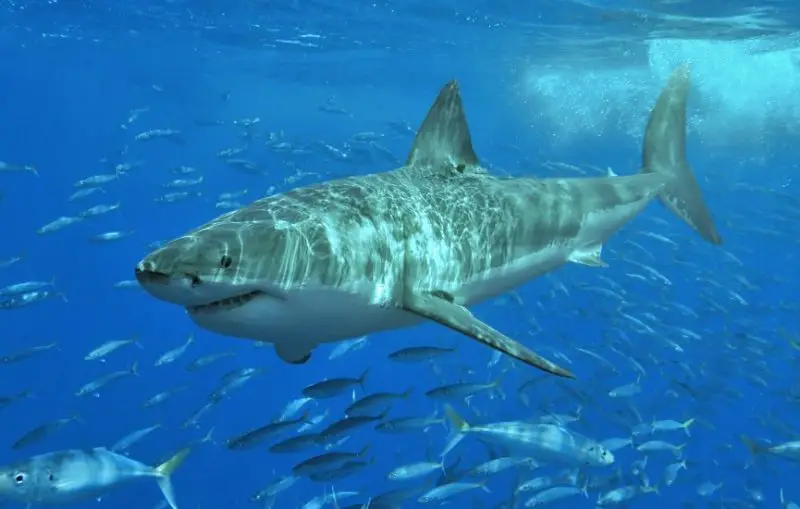
The Great White Shark is one of the most iconic and fearsome predators of the ocean, reaching lengths of up to 20 feet (6 meters) and weighing over 4,000 pounds. It has a robust, torpedo-shaped body with a conical snout, large black eyes, and powerful jaws filled with serrated teeth. Its coloration is distinct, with a white underside and a gray top, helping it blend into the ocean when viewed from above or below.
These sharks are typically found in coastal and offshore waters with temperatures ranging from 54°F to 75°F (12°C to 24°C). They are most commonly seen in regions like South Africa, Australia, California, and the northeastern United States. Great Whites prefer temperate waters but are known to migrate long distances across oceans.
Great White Sharks are apex predators, feeding on fish, rays, other sharks, and marine mammals such as seals and sea lions. They often breach the water surface in spectacular hunting displays. Despite their fearsome reputation, attacks on humans are rare and are usually due to curiosity rather than predation. They rely heavily on their keen sense of smell and ability to detect electromagnetic fields to hunt prey.
Whale Shark (Rhincodon typus)
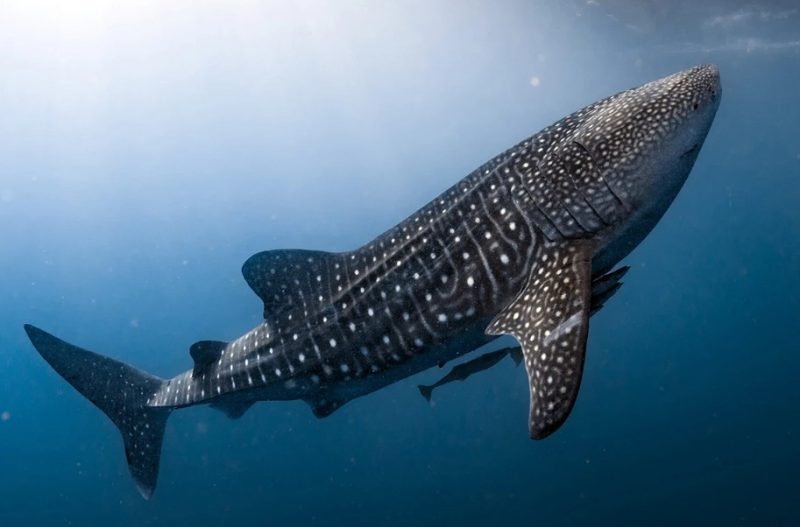
The Whale Shark holds the title as the largest fish in the ocean, growing up to 40 feet (12 meters) long and weighing more than 20 tons. Despite its size, it is a gentle giant, characterized by a broad, flat head, wide mouth, and distinctive white spots and stripes across its gray-blue body. Its gill slits are prominent, and its mouth can span over 5 feet wide.
Whale Sharks are found in tropical and warm-temperate seas around the world, including the Indian Ocean, the western Pacific, and the Caribbean. They prefer surface and midwater zones in open seas and often gather in areas with abundant plankton, such as near coral reefs or during seasonal plankton blooms.
Unlike many sharks, Whale Sharks are filter feeders, swimming slowly with their mouths open to consume plankton, small fish, and squid. They are solitary creatures for the most part but can be seen in groups during feeding aggregations. These docile sharks pose no threat to humans and are often the subject of ecotourism and conservation efforts due to their vulnerable status.
Tiger Shark (Galeocerdo cuvier)

The Tiger Shark is a large and powerful predator known for the dark vertical stripes along its body, which resemble a tiger’s pattern. Adults can reach lengths of up to 16 feet (5 meters) and are bulky with a blunt snout and large, serrated teeth. These stripes fade as the shark ages but remain a key identifier in juveniles.
This species is found in tropical and subtropical waters worldwide, especially in the central Pacific, Indian Ocean, and along the coasts of North and South America. Tiger Sharks prefer coastal areas but are also known to venture into open waters, often near islands, estuaries, and river mouths.
Tiger Sharks are opportunistic feeders with one of the broadest diets among sharks. They consume fish, birds, sea turtles, seals, and even non-food items like metal and plastic. They are nocturnal hunters, relying on their excellent sense of smell and eyesight. Although they are among the shark species involved in unprovoked attacks on humans, such incidents are rare.
Bull Shark (Carcharhinus leucas)

Bull Sharks are stocky, aggressive, and highly adaptable, capable of thriving in both saltwater and freshwater environments. They typically grow up to 11 feet (3.5 meters) long and are recognized by their blunt snouts, small eyes, and pale bellies that contrast with their gray topside.
They inhabit warm, shallow coastal waters around the globe, including the Gulf of Mexico, Amazon River, and parts of Africa and Southeast Asia. What makes Bull Sharks unique is their ability to swim far up rivers—some have even been found thousands of miles inland in freshwater lakes and rivers.
Bull Sharks are fearless and opportunistic predators, feeding on fish, dolphins, birds, and even other sharks. Their aggressive nature and proximity to human activity make them one of the top shark species involved in bites. However, like most sharks, they do not actively seek out humans and usually attack due to mistaken identity or territorial behavior.
Hammerhead Shark (Sphyrna spp.)
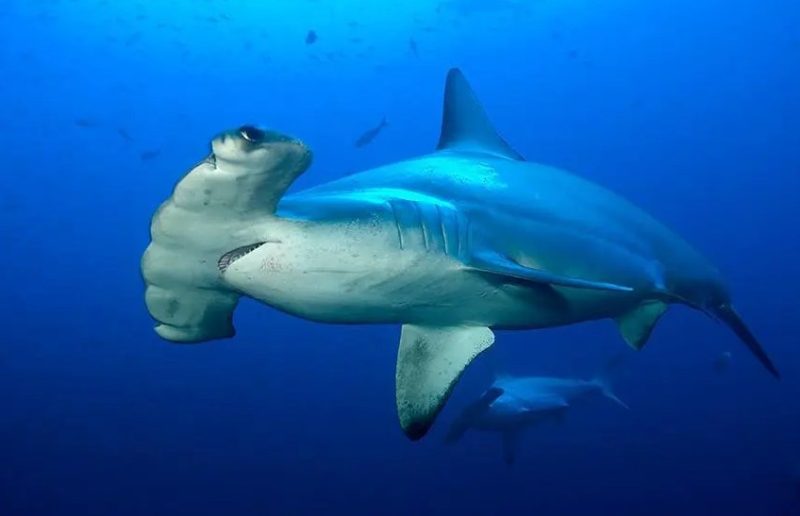
Hammerhead Sharks are instantly recognizable by their wide, flattened heads shaped like a hammer, known as a cephalofoil. This unique head structure enhances their sensory perception, particularly their ability to detect prey using electroreception. There are nine known species within the Sphyrna genus, varying in size and features.
These sharks inhabit warm coastal waters and continental shelves across the globe, often seen swimming in schools during the day and hunting alone at night. Some species, like the scalloped hammerhead, migrate seasonally and are frequently observed around seamounts and coral reefs.
Hammerhead Sharks prey on stingrays, squid, fish, and crustaceans, using their wide heads to pin prey to the ocean floor. Their enhanced vision and ability to detect electromagnetic fields make them skilled hunters. While they look intimidating, most hammerhead species are shy and avoid human interaction unless provoked.
Scalloped Hammerhead (Sphyrna lewini)
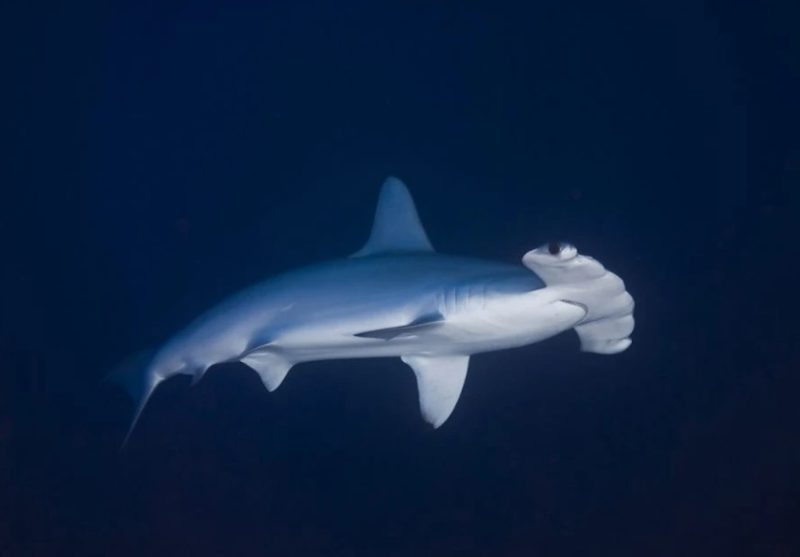
The Scalloped Hammerhead is one of the most well-known species within the hammerhead family, named for the notched or “scalloped” front edge of its distinctive head. They typically reach lengths of 8 to 12 feet (2.5 to 3.7 meters) and have a slender body with a tall, sickle-shaped dorsal fin.
They are found in warm temperate and tropical oceans worldwide, especially along continental shelves, island coasts, and near seamounts. Scalloped Hammerheads are known for forming massive schools, sometimes numbering in the hundreds, particularly around underwater ridges and islands like Cocos and Galápagos.
Scalloped Hammerheads feed on fish, squid, octopus, and rays. Their unusual head shape provides superior maneuverability and sensory advantage. Although they are generally not aggressive toward humans, their populations are declining due to overfishing and demand for shark fins, leading to their listing as a critically endangered species by the IUCN.
Great Hammerhead (Sphyrna mokarran)
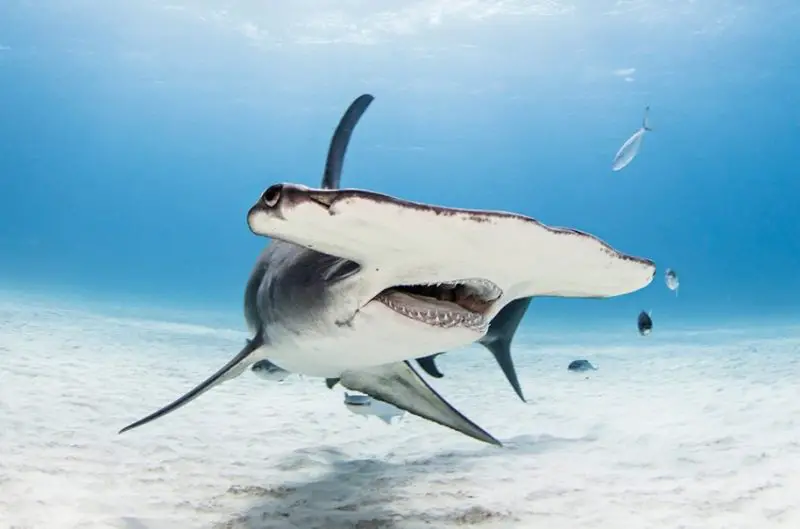
The Great Hammerhead is the largest species of hammerhead shark, reaching lengths of up to 20 feet (6 meters), though most individuals are smaller. It has a tall, nearly straight hammer-shaped head with a prominent indentation in the center. Its body is streamlined and powerful, with a tall, pointed dorsal fin that is larger than those of other hammerhead species.
This species is found in tropical and warm temperate waters worldwide, often near continental shelves, coral reefs, lagoons, and inshore waters. Great Hammerheads are solitary by nature and tend to swim alone rather than in schools, unlike some of their smaller relatives.
Great Hammerheads feed primarily on stingrays, groupers, squid, and crustaceans. Their wide cephalofoil is used to detect prey buried in the sand and to pin down stingrays. They are strong swimmers and have been known to exhibit aggressive behavior when threatened, although attacks on humans are very rare. Due to overfishing and the fin trade, they are currently listed as critically endangered.
Bonnethead Shark (Sphyrna tiburo)
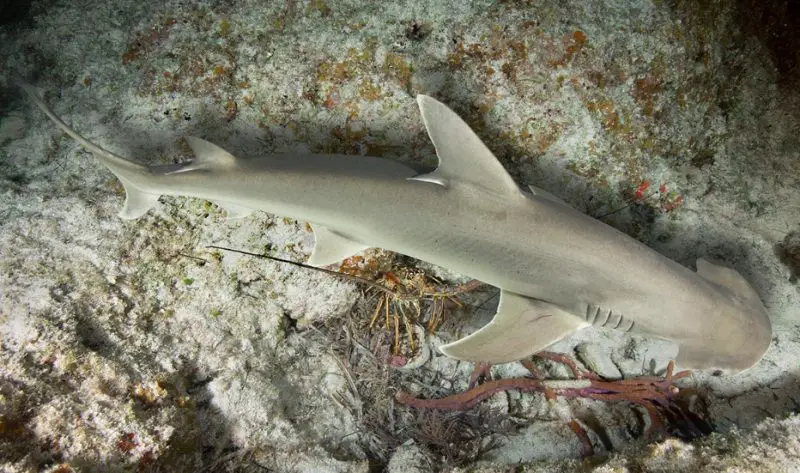
The Bonnethead Shark is the smallest member of the hammerhead family, usually growing up to 3 to 5 feet (1 to 1.5 meters) long. It has a smooth, rounded head that resembles a shovel or bonnet, giving it its name. This shark has a slender, grayish body with a lighter underside and small, narrow fins.
Bonnethead Sharks are commonly found in shallow coastal waters of the Western Atlantic and Eastern Pacific, especially along the southeastern United States, the Gulf of Mexico, and the Caribbean. They prefer sandy or muddy bottoms near seagrass beds and estuaries and are often seen in small groups or schools.
These sharks have a varied diet that includes crabs, shrimp, mollusks, and small fish, and they are one of the few known shark species to regularly consume plant matter, specifically seagrass. Their gentle nature and small size make them harmless to humans. They are an important species for marine ecosystems due to their role in controlling benthic invertebrate populations.
Oceanic Whitetip Shark (Carcharhinus longimanus)

The Oceanic Whitetip Shark is a large, slow-moving species known for its long, rounded pectoral fins and distinct white tips on its fins. Adults can reach lengths of up to 13 feet (4 meters), and they have a stocky build with a grayish-bronze coloration and a white belly.
This shark prefers the open ocean, typically found far from land in tropical and subtropical waters around the globe. It often swims near the surface and is one of the most commonly observed sharks in the pelagic zone, especially near oceanic islands and shipping routes.
Oceanic Whitetip Sharks are opportunistic feeders, preying on bony fish, squid, and even seabirds. They are known to be bold and curious, often approaching boats and divers. Historically, they have been involved in a number of shipwreck-related shark attacks. Due to overfishing and bycatch in pelagic fisheries, their numbers have declined significantly, and the species is now considered critically endangered.
Blacktip Shark (Carcharhinus limbatus)
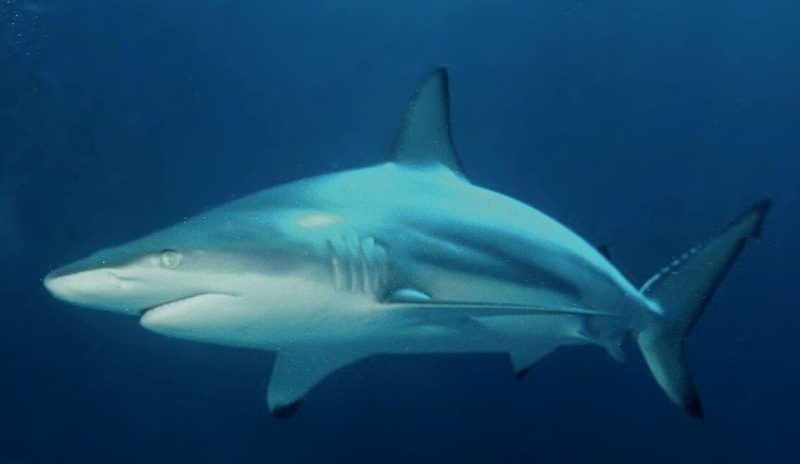
The Blacktip Shark is a sleek and agile species easily recognized by the black markings on the tips of its dorsal and pectoral fins. It typically grows to about 5 to 6 feet (1.5 to 1.8 meters) in length and has a torpedo-shaped body with a pointed snout and relatively small eyes.
This species is found in warm coastal waters around the world, including the Atlantic Ocean, Indian Ocean, and western Pacific. It is commonly seen in estuaries, bays, coral reefs, and sometimes in the open sea. Blacktip Sharks often migrate seasonally, following warm water currents and prey availability.
Blacktip Sharks feed on schooling fish such as sardines, mullet, and herring, as well as squid and crustaceans. They are known for their energetic behavior and are capable of leaping from the water while feeding. While they may come close to shore and are occasionally involved in minor incidents with humans, they are generally shy and pose little threat.
Silvertip Shark (Carcharhinus albimarginatus)

The Silvertip Shark is named for the distinctive white or silvery edges on its fins, which contrast sharply with its otherwise gray body. It typically grows up to 8 feet (2.4 meters) in length and has a broad snout, large eyes, and robust build that makes it a formidable predator.
Silvertip Sharks are found in warm tropical and subtropical waters throughout the Indo-Pacific region, especially around coral reefs, offshore islands, and drop-offs. They are often seen cruising over deep reef slopes and can be found from the surface to depths of over 2,600 feet (800 meters).
Their diet consists mainly of bony fish, rays, and smaller sharks. Silvertips are solitary and territorial, sometimes displaying dominance over other sharks in their habitat. While they are curious and can become bold when approached, attacks on humans are extremely rare. However, their declining population due to overfishing has led to concern about their conservation status.
Shortfin Mako Shark (Isurus oxyrinchus)
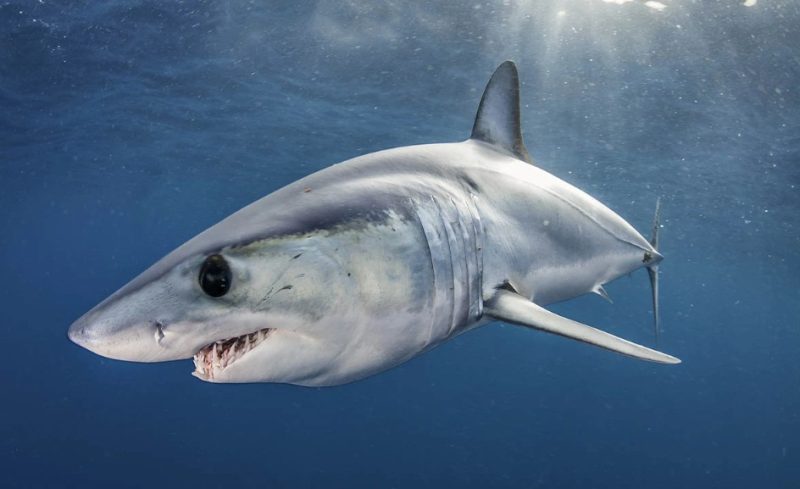
The Shortfin Mako Shark is known as the fastest shark in the ocean, capable of reaching speeds up to 45 miles per hour (72 kilometers per hour). It has a streamlined, torpedo-shaped body, a pointed snout, and striking blue coloration on its back with a stark white underside. Adults typically measure between 10 to 12 feet (3 to 3.6 meters) in length.
This species is widely distributed in temperate and tropical offshore waters worldwide, often found far from shore but occasionally seen closer to the coast during migrations. It prefers open ocean environments where it can hunt in the pelagic zone and follow migratory prey.
Shortfin Makos feed primarily on fast-swimming fish like tuna, mackerel, and swordfish, as well as squid. They are highly active, powerful hunters with a reputation for leaping out of the water when hooked. Though not typically aggressive toward humans, they can be dangerous when provoked or caught. They are a prized game fish, and their populations have suffered from overfishing and bycatch, leading to a vulnerable conservation status.
Longfin Mako Shark (Isurus paucus)
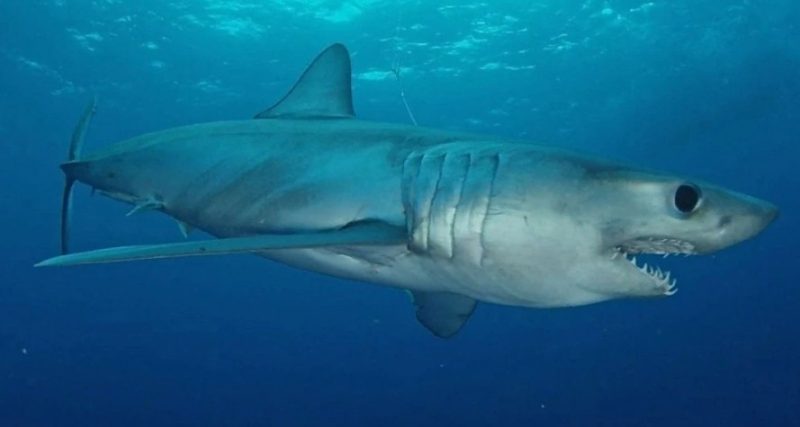
The Longfin Mako Shark is a rare and elusive species, closely related to the more well-known Shortfin Mako. It can be distinguished by its longer pectoral fins and slightly bulkier body. Adults typically grow to about 13 feet (4 meters) in length and have a dark metallic blue coloration on the back, fading to white underneath.
This species inhabits deep offshore waters of tropical and warm temperate oceans worldwide, though sightings are infrequent due to its deepwater nature. It is believed to spend much of its time in the mesopelagic zone, far from coastal areas and the ocean surface.
The Longfin Mako’s diet is not well-documented, but it likely includes squid and deepwater fish. Due to its scarcity and limited encounters, much of its behavior remains a mystery. It is rarely caught by fisheries, but when it is, it is often mistaken for the Shortfin Mako. The species is currently listed as endangered due to its rarity and vulnerability to deep-sea fishing pressures.
Goblin Shark (Mitsukurina owstoni)
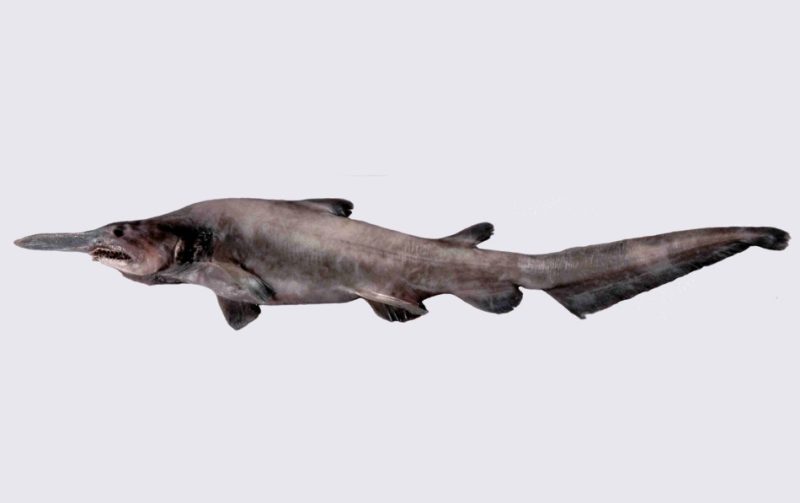
The Goblin Shark is one of the most bizarre-looking shark species, easily recognized by its long, flattened snout and protrusible jaws filled with slender, needle-like teeth. Its body is soft and flabby, usually pinkish or pale gray, with adults reaching lengths of around 10 to 13 feet (3 to 4 meters).
This deep-sea species is found in scattered locations around the globe, usually at depths ranging from 330 to over 4,000 feet (100 to 1,200 meters). It is most often encountered off the coasts of Japan, South Africa, and the Gulf of Mexico. Due to its deep habitat, it is rarely seen by humans.
Goblin Sharks are slow-moving ambush predators that feed on deep-sea fish, crustaceans, and cephalopods. They use their highly extendable jaws to snap up prey with sudden precision. Despite their eerie appearance, they pose no threat to humans and are of little interest to commercial fisheries. However, accidental capture and deep-sea habitat threats still impact their population.
Megamouth Shark (Megachasma pelagios)

The Megamouth Shark is a large, filter-feeding shark known for its enormous, gaping mouth lined with small, hook-like teeth. It can reach lengths of up to 16 feet (5 meters) and has a soft, flabby body with a dark brown to grayish-black coloration. It is one of the rarest shark species ever observed.
This deepwater species has been found in temperate and tropical oceans around the world, though confirmed sightings are extremely limited. It is believed to perform diel vertical migrations, coming closer to the surface at night and descending to deeper waters during the day.
Megamouth Sharks feed by swimming with their mouth open to filter plankton, jellyfish, and small crustaceans from the water. They are slow swimmers and have a gentle nature. Since their discovery in 1976, fewer than 100 specimens have been documented, making them one of the least understood sharks in the ocean. Conservation concerns remain minimal due to their rarity and lack of targeted fishing.
Basking Shark (Cetorhinus maximus)
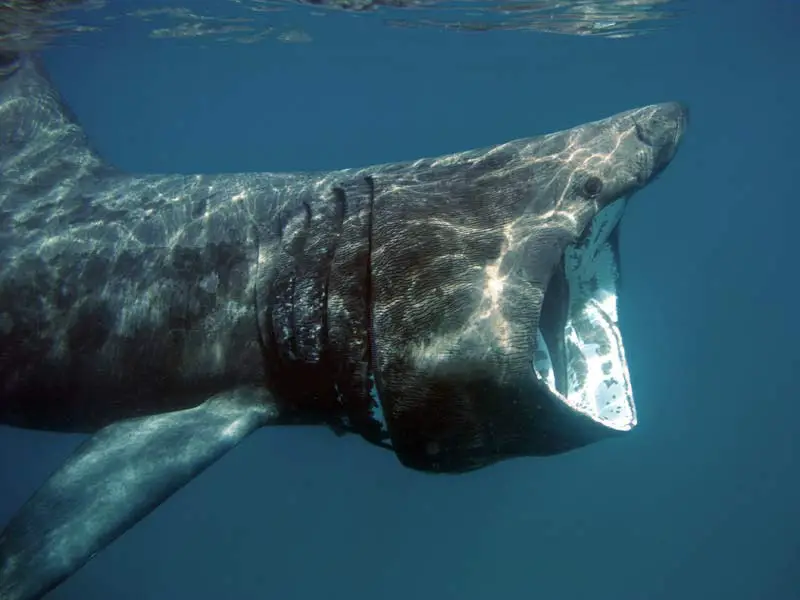
The Basking Shark is the second-largest fish in the world, reaching lengths of up to 40 feet (12 meters). It has a massive, gaping mouth and a cone-shaped snout, with a grayish to brown coloration and rough, sandpaper-like skin. Despite its size, it poses no threat to humans due to its filter-feeding lifestyle.
This species is commonly found in temperate coastal waters of the Atlantic and Pacific Oceans, especially around the British Isles, Canada, and the northeastern United States. It often swims near the surface in spring and summer, filtering plankton from the water using gill rakers.
Basking Sharks are slow, gentle swimmers and often seen alone or in small groups. They migrate long distances to follow food sources and may dive to deep waters during the winter months. Historically hunted for their liver oil and fins, their populations have declined significantly, and they are now considered endangered.
Salmon Shark (Lamna ditropis)
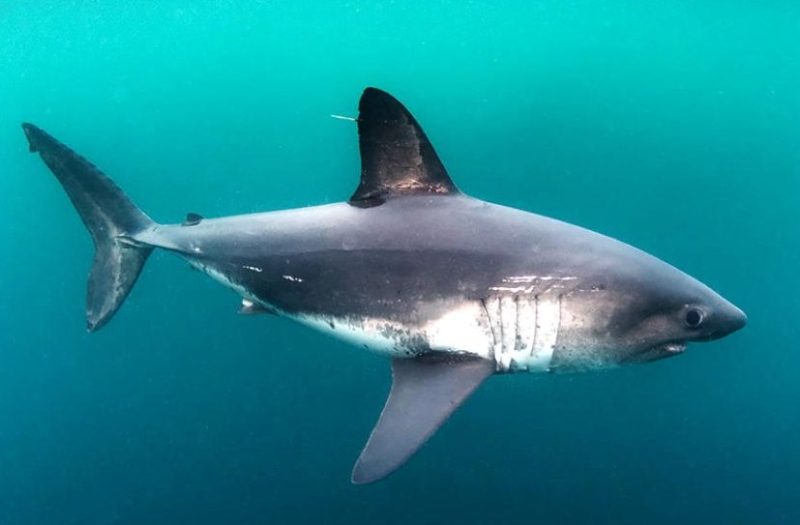
The Salmon Shark is a powerful, fast-swimming predator known for its resemblance to the Great White Shark, though it is smaller in size. Adults typically reach 6 to 10 feet (1.8 to 3 meters) in length and have a dark gray to bluish-black back with a white underside and strong, torpedo-shaped bodies.
This shark inhabits the North Pacific Ocean, especially in colder waters off the coasts of Alaska, Japan, and British Columbia. It often enters coastal bays and estuaries, especially during salmon spawning runs, hence its name. Unlike many sharks, it can regulate its internal body temperature to survive in cold environments.
Salmon Sharks feed primarily on salmon, squid, herring, and other fish. They are known for their aggressive feeding behavior and incredible bursts of speed. Though they rarely interact with humans, they are occasionally caught as bycatch or targeted for sport fishing. Their population is considered stable, but localized pressures may affect specific regions.
Porbeagle Shark (Lamna nasus)
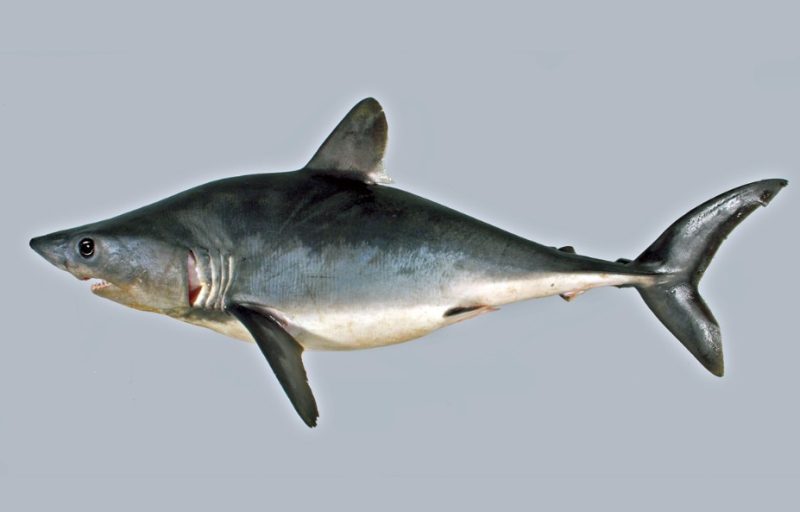
The Porbeagle Shark is a robust, cold-water shark with a thick, torpedo-shaped body and a distinctively short, conical snout. It typically grows to about 6 to 8 feet (1.8 to 2.5 meters) in length and has a steel-blue back with a white belly. A small white patch on the back edge of the dorsal fin is a key identifying feature.
This species is found in the cold temperate waters of the North Atlantic and Southern Hemisphere, often in offshore environments and occasionally closer to shore during seasonal migrations. It prefers waters between 32 to 63°F (0 to 17°C) and is known to dive to great depths in search of prey.
Porbeagle Sharks feed on a variety of fish including mackerel, herring, and squid. They are energetic, fast swimmers and are considered one of the few shark species capable of endothermy, allowing them to maintain body heat in cold waters. While not aggressive toward humans, they are vulnerable due to high commercial fishing pressure and are listed as vulnerable in many parts of their range.
Thresher Shark (Alopias spp.)
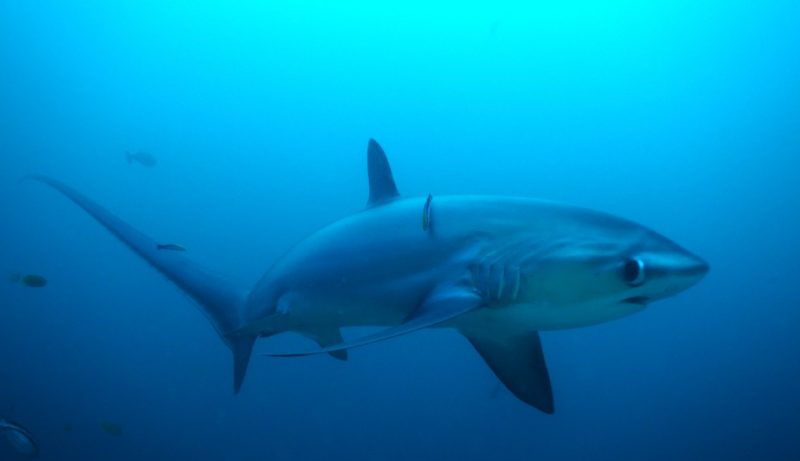
Thresher Sharks are easily recognized by their long, whip-like tails that can be as long as their bodies. These sharks usually range between 10 to 20 feet (3 to 6 meters) depending on the species, and they have slender bodies with short, pointed snouts and large eyes. Their coloration typically includes a dark bluish-gray back and a lighter underside.
Thresher Sharks inhabit both coastal and pelagic waters in temperate and tropical oceans around the world. They are often found far from shore but may come closer to coastal areas during feeding. These sharks are solitary and elusive, making them hard to spot in the wild.
One of the most unique behaviors of Thresher Sharks is their method of hunting. They use their elongated tails to stun schools of fish such as sardines or mackerel before circling back to consume the immobilized prey. They are generally harmless to humans and are often targeted by sport fishermen for their strength and agility.
Bigeye Thresher Shark (Alopias superciliosus)
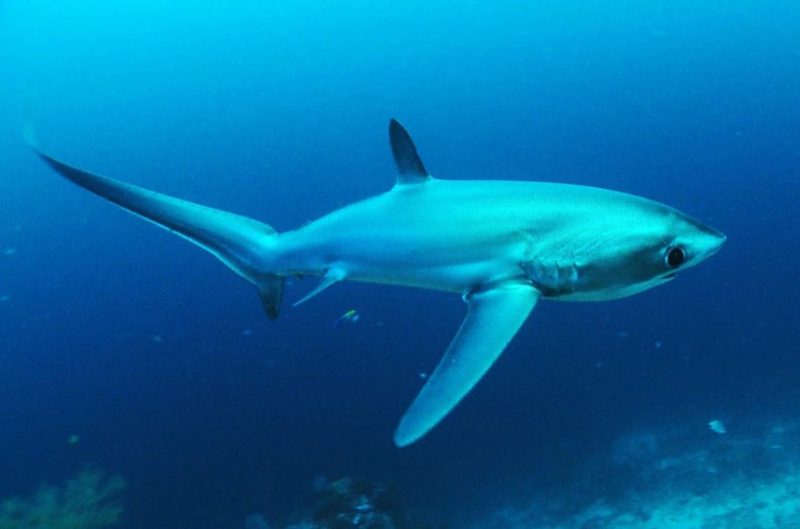
The Bigeye Thresher Shark is named for its enormous eyes, which are adapted for hunting in low-light conditions of deep water. It has a distinctively arched head and long upper tail fin, growing up to 16 feet (4.9 meters) in length. The body is typically dark purple-gray above and lighter below.
This species prefers deep offshore habitats in tropical and temperate oceans worldwide. It is often found at depths between 300 and 500 feet (90 to 150 meters), although it sometimes moves into shallower waters during the night to hunt. Its large eyes help it see in the dimly lit environment of the mesopelagic zone.
Bigeye Thresher Sharks are solitary and mainly feed on squid and deepwater fish. Their long tails are used to strike and disable prey with precise slaps. They are considered vulnerable due to their slow reproductive rate and are frequently caught as bycatch in longline fisheries.
Common Thresher Shark (Alopias vulpinus)
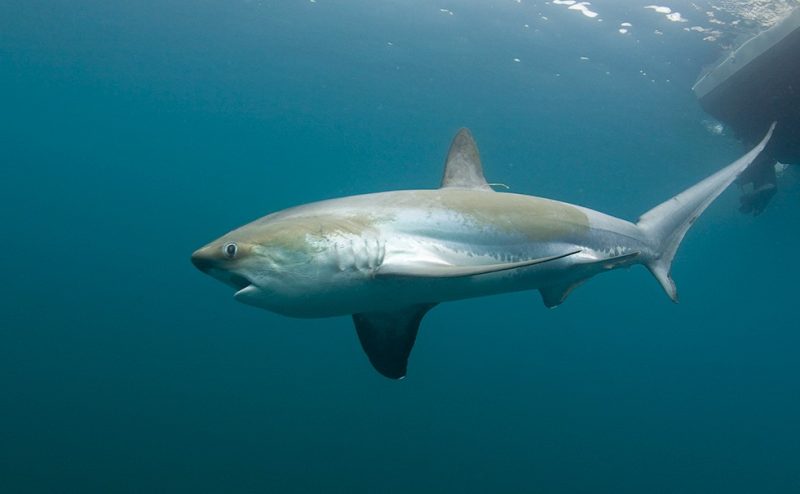
The Common Thresher Shark is the most widely distributed of the thresher species and can reach lengths of up to 20 feet (6 meters), with about half of that length consisting of the tail. It has a streamlined body, a pointed snout, and large eyes, making it well-suited for high-speed chases.
This species is found in temperate and subtropical waters around the world, often in coastal regions and over continental shelves. It is known to approach the surface and is sometimes seen breaching. Juveniles may be found closer to shore, while adults prefer deeper waters.
Common Threshers feed primarily on schooling fish like mackerel and herring. They are powerful swimmers and use their long tails to strike and corral fish with impressive accuracy. They are popular targets in sport fisheries due to their size and fighting ability, though they are vulnerable to overfishing due to their slow growth and low reproduction rate.
Pelagic Thresher Shark (Alopias pelagicus)
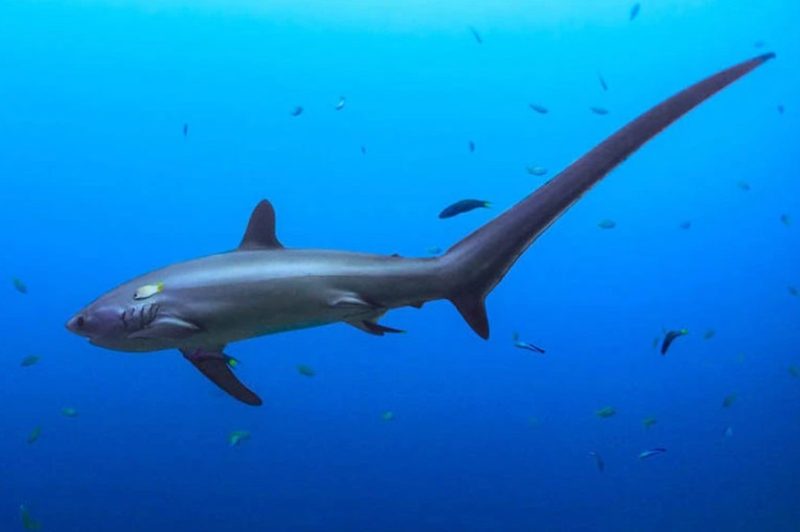
The Pelagic Thresher Shark is the smallest of the three thresher species, usually growing up to about 10 feet (3 meters) in length. It has a slender body, a narrow head, and an extremely long, scythe-like tail that it uses for hunting. Its coloration is typically a deep metallic blue on the back with a white underside.
As its name suggests, this shark inhabits the open ocean, especially in tropical and subtropical regions of the Indo-Pacific. It prefers offshore areas and is often found in the upper layers of the ocean, especially near seamounts and drop-offs.
The Pelagic Thresher hunts small pelagic fish and squid using its tail to strike and immobilize prey. Unlike other threshers, it is more likely to be found in clear, warm surface waters. Though shy and rarely aggressive, it is often caught as bycatch and is listed as endangered due to population declines from unsustainable fishing practices.
Zebra Shark (Stegostoma fasciatum)
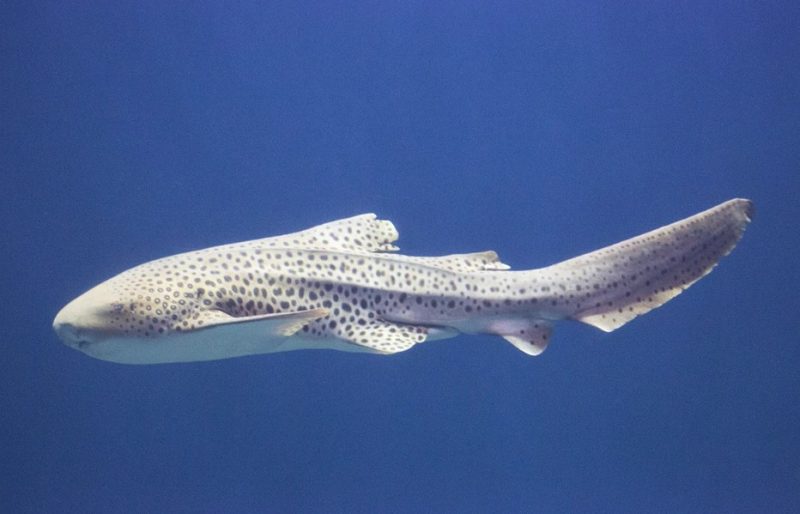
The Zebra Shark is a unique bottom-dwelling shark with a long, cylindrical body and ridged back. Juveniles have dark bodies with light stripes, which resemble a zebra’s pattern, while adults develop pale yellowish-brown skin with dark spots. They can grow up to 8 feet (2.4 meters) in length.
This species is found in shallow tropical waters of the Indo-Pacific region, often near coral reefs and sandy bottoms. It typically rests on the seafloor during the day and becomes more active at night, using its strong pectoral fins to “walk” along the substrate in search of food.
Zebra Sharks feed primarily on mollusks, crustaceans, and small fish. They use their small mouths and strong jaws to crush hard-shelled prey. Harmless to humans, they are popular in public aquariums due to their distinctive appearance and calm demeanor. Although not commercially targeted, habitat degradation and accidental capture threaten some populations.
Nurse Shark (Ginglymostoma cirratum)

The Nurse Shark is a slow-moving, bottom-dwelling species recognized by its broad head, small eyes, and two barbels near the nostrils. It has a yellowish-brown to grayish-brown body and can grow up to 10 feet (3 meters) in length. Its skin is tough and covered with tiny denticles, giving it a rough texture.
This species inhabits warm, shallow waters in the western Atlantic and eastern Pacific Oceans, commonly around coral reefs, mangroves, and sandy bottoms. It is often found resting motionless during the day in groups and becomes more active at night.
Nurse Sharks are suction feeders that use their powerful mouths to suck in prey such as crustaceans, mollusks, and small fish. They are non-aggressive and usually ignore divers unless provoked. Because of their docile nature, they are often featured in shark tourism and public aquariums. Overfishing and habitat destruction pose local threats, but their overall population remains relatively stable.
Wobbegong (Orectolobus spp.)
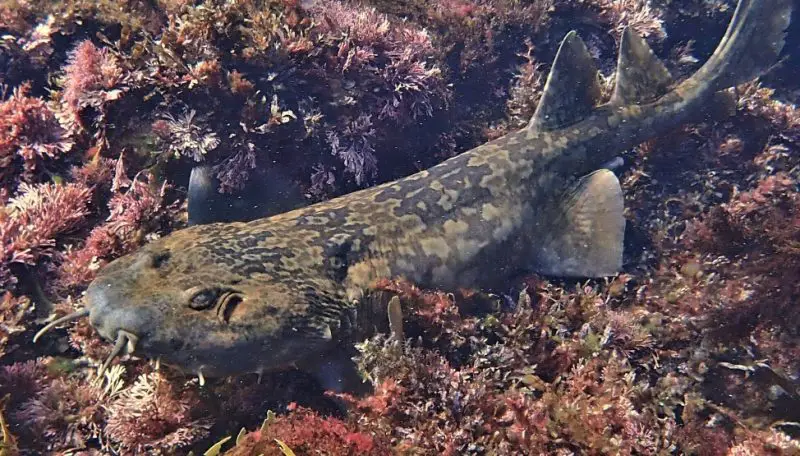
Wobbegongs are a group of carpet sharks known for their flattened bodies, broad heads, and ornate, camouflaged patterns that resemble the ocean floor. They typically range from 3 to 10 feet (1 to 3 meters) in length depending on the species. Their unique appearance is enhanced by fleshy lobes around their mouths which help them blend into coral and rock crevices.
These sharks are native to the Indo-Pacific region, especially around Australia and Indonesia. They are bottom-dwellers found in shallow coastal waters, reefs, and rocky habitats. During the day, they often lie motionless on the seabed, concealed by their coloration.
Wobbegongs are ambush predators that feed primarily at night on fish, crustaceans, and octopuses. They use their excellent camouflage to wait patiently for prey to swim close before striking. Though not aggressive, they can bite if disturbed, especially by divers who accidentally get too close.
Epaulette Shark (Hemiscyllium ocellatum)
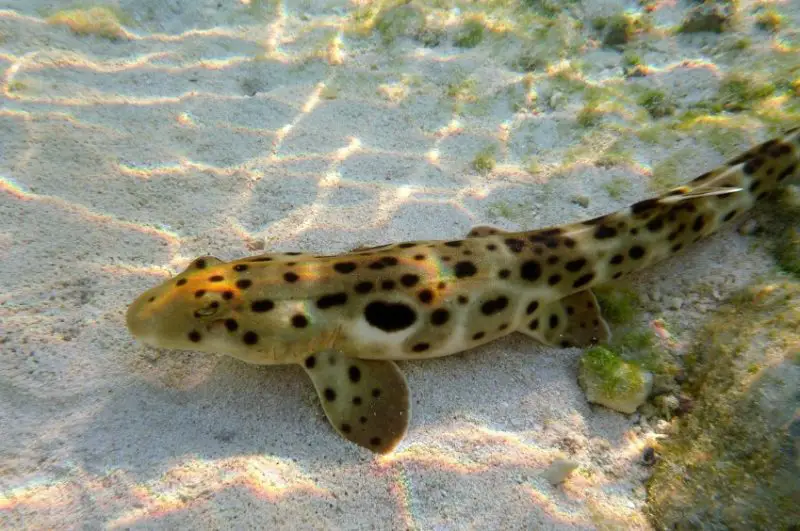
The Epaulette Shark is a small, slender species best known for the distinctive large, dark spot behind each pectoral fin that resembles an epaulette on a uniform. It usually grows to about 3 feet (1 meter) in length and has a light brown body covered with small dark spots.
This species is found in shallow coral reef habitats of northern Australia and New Guinea. It prefers tidal pools and lagoon areas where water levels fluctuate significantly. Its ability to survive in low-oxygen environments makes it highly adaptable to these challenging conditions.
Epaulette Sharks are unique for their ability to “walk” using their pectoral and pelvic fins. They often move across exposed reef flats and even land-like surfaces during low tides. Their diet consists of small invertebrates and worms, and they are harmless to humans. Their small size and interesting behavior make them popular in aquariums.
Bamboo Shark (Chiloscyllium spp.)

Bamboo Sharks are small, bottom-dwelling sharks with elongated bodies and distinct patterns of dark bands or spots across their light-colored skin. Adults typically grow between 2.5 and 3.5 feet (0.7 to 1 meter) in length, depending on the species. They have short snouts and a smooth, graceful appearance.
These sharks inhabit shallow tropical waters in the Indo-Pacific region, including reefs, sandy flats, and mangrove areas. They prefer environments with plenty of hiding spots where they can rest during the day. Some species are commonly seen in intertidal zones and tide pools.
Bamboo Sharks are nocturnal and feed on small crustaceans, mollusks, and worms. They are known for their calm temperament and adaptability to captivity, making them popular in marine aquariums. Despite their limited commercial value, they are vulnerable to habitat degradation and pollution in their natural environments.
Horn Shark (Heterodontus francisci)
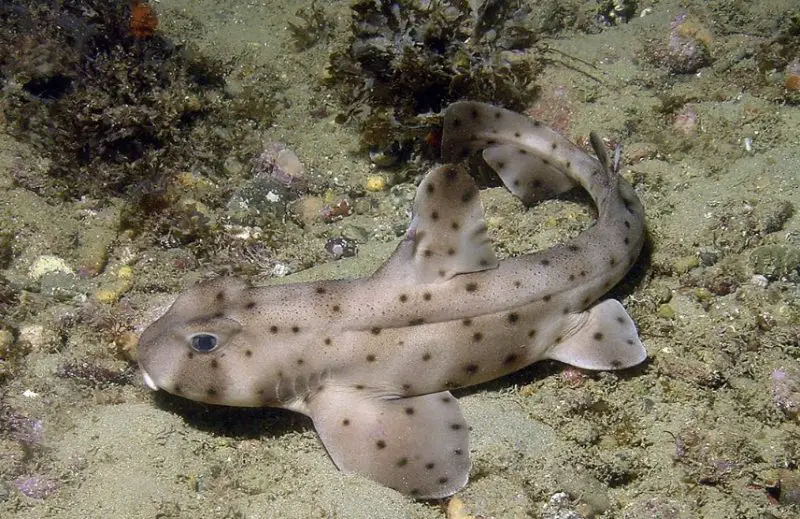
The Horn Shark is a small, stout-bodied species with a blunt head, prominent ridges above the eyes, and two dorsal fins each equipped with a sharp spine. Its body is typically brown or grayish with small dark spots and reaches a maximum length of around 4 feet (1.2 meters).
This shark is native to the eastern Pacific Ocean, particularly along the coast of California and Baja California. It inhabits rocky reefs, kelp forests, and sandy bottoms at depths ranging from shallow waters to about 600 feet (180 meters). During the day, it tends to rest in caves or crevices.
Horn Sharks are slow-moving and nocturnal, feeding on hard-shelled prey such as sea urchins, crabs, and mollusks. Their strong jaws and molar-like teeth are adapted for crushing shells. Though not aggressive, their dorsal spines can cause injury if handled carelessly. They are often studied for their unique egg-laying behavior and site fidelity.
Port Jackson Shark (Heterodontus portusjacksoni)

The Port Jackson Shark is a stout, bottom-dwelling species with a distinctive harness-like pattern over its back and a blunt, pig-like snout. It can grow up to 5.5 feet (1.7 meters) long and has two dorsal fins, each with a sharp spine. Its coloration is typically light gray to brown with dark markings.
It is commonly found in the temperate waters around southern Australia, including rocky reefs and sandy sea floors. The species prefers depths from the shoreline down to 300 feet (90 meters), and it often shelters in caves or under ledges during the day.
Port Jackson Sharks feed primarily at night on sea urchins, crustaceans, and mollusks, using their strong, flattened teeth to crush shells. They are known for laying spiral-shaped egg cases that wedge into rock crevices. Though they may look intimidating due to their spines, they are generally docile and harmless to humans.
Spiny Dogfish (Squalus acanthias)
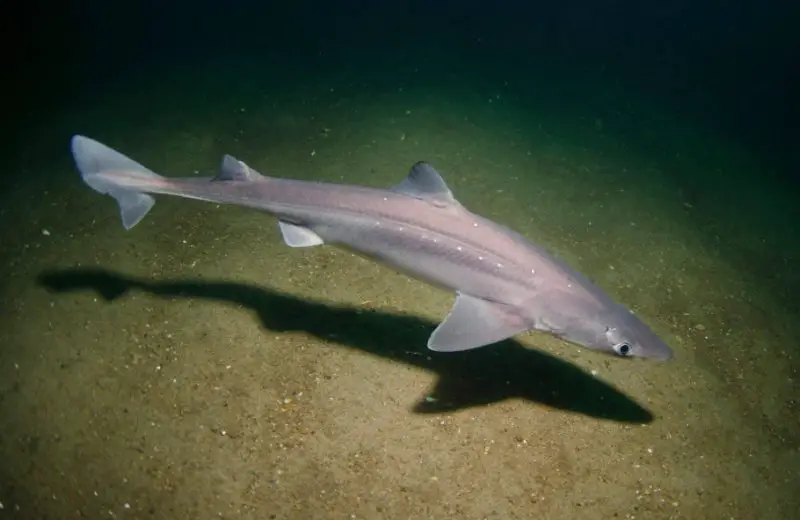
The Spiny Dogfish is a small, slender shark with a pointed snout, no anal fin, and a pair of venomous spines in front of each dorsal fin. Adults typically reach lengths of about 3 to 4 feet (0.9 to 1.2 meters). Its back is gray or brownish, and the belly is white, sometimes with small spots along the sides.
This species is widely distributed in temperate and subarctic waters of the Atlantic and Pacific Oceans. It inhabits coastal waters, continental shelves, and sometimes brackish estuaries. Spiny Dogfish often travel in large schools and are known for their long migratory behavior.
They feed on a wide variety of fish, squid, and invertebrates. Despite their small size, Spiny Dogfish are persistent hunters and have been observed in coordinated group feeding. They are important in commercial fisheries but are vulnerable to overfishing due to their slow growth and late maturity.
Greenland Shark (Somniosus microcephalus)
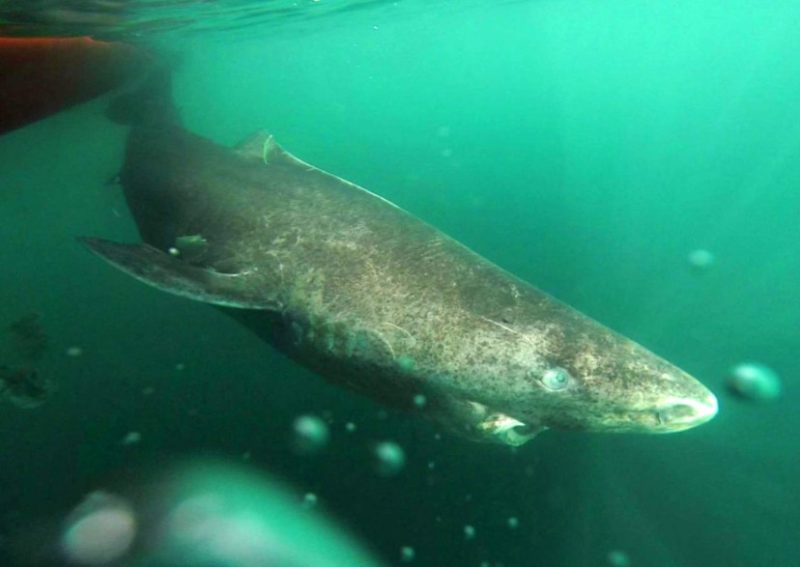
The Greenland Shark is one of the largest species of shark found in the Arctic and North Atlantic Oceans. It has a stout body, with a relatively small head and a short, blunt snout. This slow-moving shark can grow up to 24 feet (7.3 meters) long, though most individuals are much smaller, typically around 15 feet (4.5 meters). It has a dull grayish-brown to dark brown coloration, often with a rough texture.
Found primarily in the cold, deep waters of the Arctic, Greenland Sharks inhabit areas around Greenland, Canada, Iceland, and other parts of the North Atlantic. These sharks are known to prefer depths of 200 to 2,200 feet (60 to 670 meters) and are often associated with the coldest waters, often found in dark, icy regions.
Greenland Sharks are opportunistic feeders and have a diet that includes fish, seals, and even carcasses of whales. They are also known for their incredibly slow metabolism and can live for several hundred years, making them one of the longest-living vertebrates. Despite their large size, they are not dangerous to humans and tend to be more of a curiosity to researchers.
Frilled Shark (Chlamydoselachus anguineus)
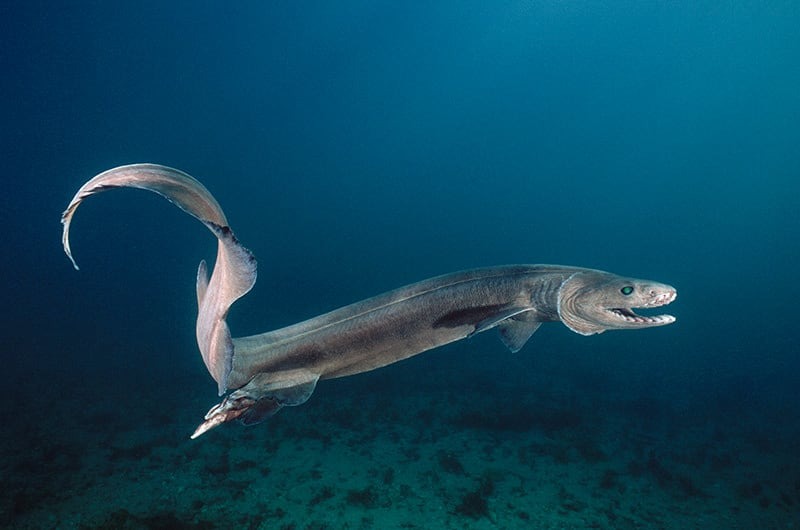
The Frilled Shark is a rare and ancient species often described as a living fossil due to its primitive features. It has a long, eel-like body with a broad head and large, sharp teeth, which are arranged in several rows. The shark can grow up to 6.5 feet (2 meters) long and has distinctive frilled gill slits, which give the species its name.
Frilled Sharks are deep-sea dwellers found at depths ranging from 200 to 1,500 feet (60 to 460 meters) in the waters of the Atlantic and Pacific Oceans. They are typically found off the coasts of Japan, the Mediterranean Sea, and around parts of South America, where they remain largely hidden in the dark depths of the ocean.
This species is a slow swimmer and is known for its ambush predation style. The Frilled Shark feeds mainly on squid, fish, and smaller sharks. Its unique tooth structure and the frilled appearance of its gills are evolutionary traits that allow it to capture prey in the dark, murky depths where visibility is minimal.
Cookiecutter Shark (Isistius brasiliensis)

The Cookiecutter Shark is a small but distinctive species known for the round, cookie-shaped bite marks it leaves on its prey. It typically reaches lengths of about 1.5 feet (0.5 meters), with a cylindrical body and a large mouth equipped with sharp, triangular teeth. The shark’s dark brown or grayish back contrasts with its light-colored belly, helping it blend in with the ocean depths.
Cookiecutter Sharks are found in warm, tropical, and subtropical waters, including the Atlantic, Pacific, and Indian Oceans. They inhabit depths of around 300 to 2,500 feet (90 to 750 meters), often around offshore islands and deepwater ridges. Their preferred habitats are characterized by poor visibility and cold temperatures.
These sharks are known for their parasitic feeding behavior. They attach to larger animals, such as whales, dolphins, and even submarines, and take small chunks of flesh. The unique bite pattern from their circular teeth gives them their common name. Despite their unusual feeding method, they are not a threat to humans and rarely interact with people.
Velvet Belly Lanternshark (Etmopterus spinax)
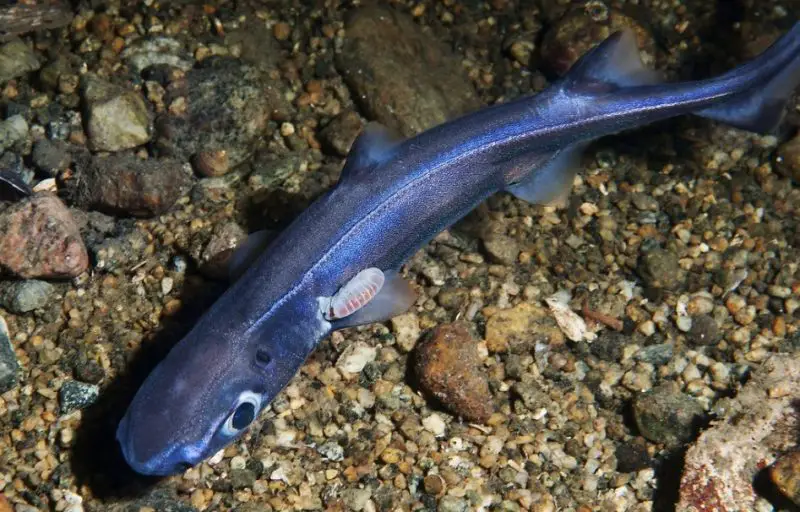
The Velvet Belly Lanternshark is a small, bioluminescent shark species that thrives in the deep waters of the northeastern Atlantic and Mediterranean Seas. It typically reaches about 1.3 feet (40 cm) in length and has a dark, velvety body with a faint glow due to specialized light-producing organs along its belly.
These sharks are typically found at depths between 650 and 2,500 feet (200 to 760 meters), where they use their bioluminescence to attract prey or camouflage against predators. Their habitat includes steep continental slopes and underwater ridges where light from the surface is minimal, allowing the shark to rely on its glow.
The Velvet Belly Lanternshark is a nocturnal feeder, preying on small fish, crustaceans, and squid. It uses its ability to produce light to help in hunting and evading predators. While not dangerous to humans, it is a fascinating species due to its adaptation to the deep-sea environment and its unique glowing features.
Sleeper Shark (Somniosus spp.)
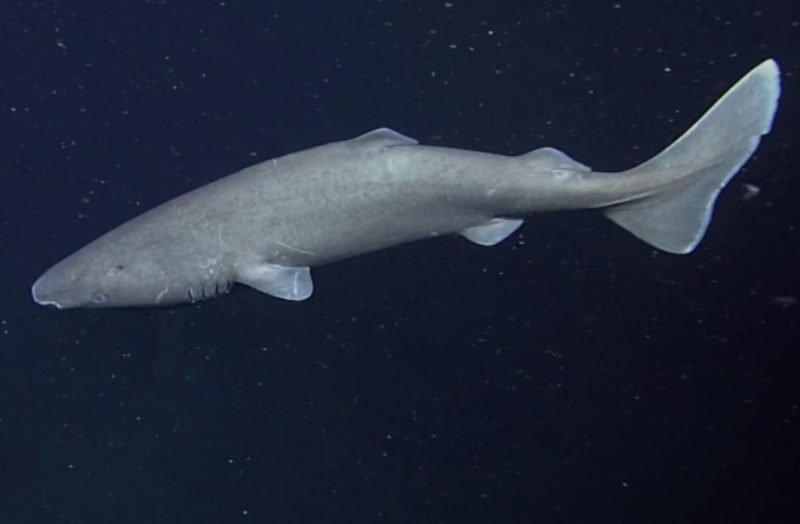
Sleeper Sharks are a group of slow-moving, deepwater sharks that are found in cold waters of both the Arctic and Antarctic Oceans. These sharks are characterized by their thick, stocky bodies and short, blunt snouts. They typically grow to lengths between 6 and 14 feet (1.8 to 4.3 meters), depending on the species.
Sleeper Sharks are typically found in deep, cold waters, ranging from 200 to 2,500 feet (60 to 750 meters). They inhabit oceanic regions in both the Northern and Southern Hemispheres, with specific species found near Greenland, Alaska, and the southern oceans around Antarctica. These sharks are well-adapted to their cold, deepwater environments.
Despite their large size, Sleeper Sharks are slow-moving and not aggressive towards humans. Their diet consists mainly of fish and squid, and they are opportunistic feeders, sometimes scavenging from carcasses of large marine mammals. They are also known for their ability to survive in extremely cold, low-oxygen environments due to their slow metabolism.
Angular Roughshark (Oxynotus centrina)

The Angular Roughshark is a small, deep-water species found in the Eastern Atlantic Ocean. It is characterized by its rough, angular body with large, wide-set eyes and prominent spines along the dorsal fins. This shark typically grows up to 3 feet (1 meter) long and has a grayish-brown body with irregular dark markings.
The Angular Roughshark prefers to live in deep waters ranging from 300 to 1,800 feet (90 to 550 meters) along continental slopes and underwater ridges. It is commonly found off the coasts of Spain, Portugal, and parts of Morocco. Due to its deep-sea habitat, the shark remains relatively elusive and is rarely encountered by humans.
This species is primarily a scavenger, feeding on small fish, squid, and invertebrates. The Angular Roughshark is known for its defensive behavior, using its sharp spines to deter potential predators. It is a slow-moving, solitary shark that avoids human interaction, staying hidden in the dark depths of the ocean.
Ghost Shark (Chimaera spp. – technically not true sharks)

The Ghost Shark, also known as the Chimaera, is a cartilaginous fish that resembles sharks but is technically not a true shark. These deep-sea fish have elongated bodies, large pectoral fins, and a distinctive, ghostly appearance, with large eyes that contribute to their name. They can reach lengths of up to 5 feet (1.5 meters), with a smooth, pale body that helps them blend into their dark, deep-sea environment.
Ghost Sharks are typically found at depths ranging from 200 to 2,600 feet (60 to 800 meters) in temperate and cold waters. They inhabit the continental slopes and deep regions of oceans, particularly around New Zealand, Australia, and the eastern coasts of the Pacific Ocean. Despite their shark-like features, they are more closely related to rays and skates.
These fish are solitary and slow-moving, feeding primarily on benthic invertebrates such as crustaceans, mollusks, and small fish. They are often found in the darkest depths of the ocean, where their bioluminescence helps them attract prey and evade predators. Despite their eerie appearance, Ghost Sharks are not considered a threat to humans.
Sawshark (Pristiophorus spp.)
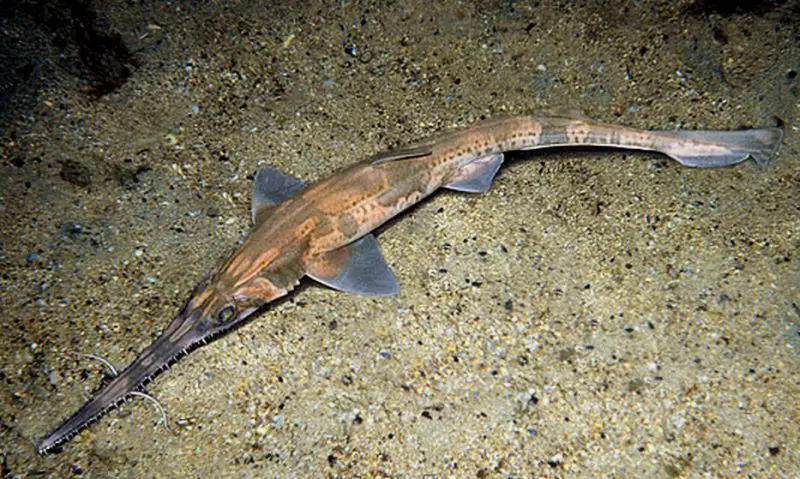
The Sawshark is a unique species of shark recognized for its long, flattened snout that resembles a saw blade. This elongated rostrum is covered in sharp teeth and is used by the Sawshark to slice through the sand and mud to uncover buried prey, such as small fish and crustaceans. Sawsharks typically grow up to 4.5 feet (1.4 meters) in length and have a sleek, cylindrical body with a pale to grayish coloration.
Sawsharks are found in temperate and tropical waters, with species primarily located in the Indian, Pacific, and Atlantic Oceans. They are often seen at depths ranging from 100 to 1,500 feet (30 to 460 meters), especially along continental slopes and offshore regions. Their habitat is characterized by sandy or muddy ocean floors, where they search for prey.
These sharks are bottom-dwelling predators that use their saw-like snouts to hunt by thrashing them side to side, disorienting prey and making it easier to catch. They feed on small fish, crustaceans, and cephalopods, using their specialized rostrum to create a sweeping motion through the seabed. Although they are not dangerous to humans, they are rarely encountered due to their preference for deeper waters.
Shortnose Sawshark (Pristiophorus nudipinnis)
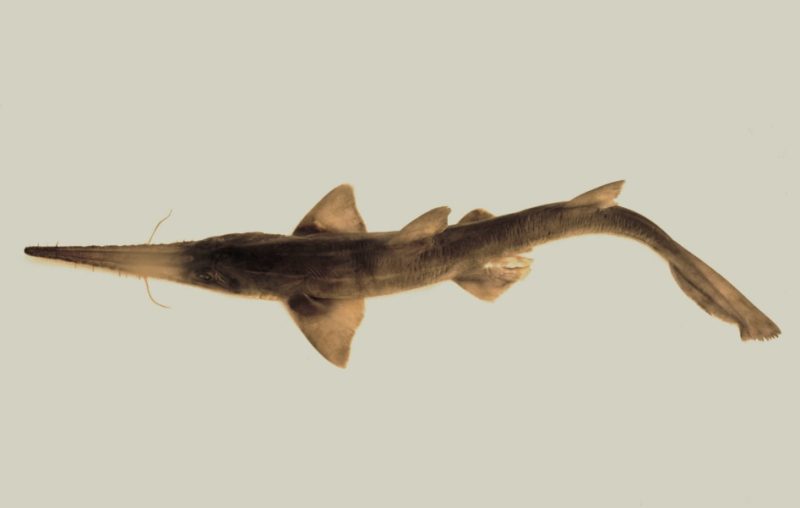
The Shortnose Sawshark is a smaller species of Sawshark that grows up to 4 feet (1.2 meters) in length. Characterized by its short, saw-like snout with sharp teeth, this shark uses its rostrum to dig into the ocean floor and uncover buried prey. Its body is slender, with a brown or grayish color that provides camouflage against the sandy bottom.
This species is found in the Indo-Pacific region, particularly around Australia and Indonesia, inhabiting depths of 100 to 650 feet (30 to 200 meters). The Shortnose Sawshark is typically found along continental shelves and the outer regions of coastal areas, where it feeds on small fish and invertebrates.
The Shortnose Sawshark’s behavior is similar to other Sawsharks; it uses its specialized snout to sweep through the sand and mud in search of food. They are not aggressive towards humans and are more likely to avoid contact. Due to their size and elusive nature, they are not commonly encountered by divers or fishers.
Longnose Sawshark (Pristiophorus cirratus)
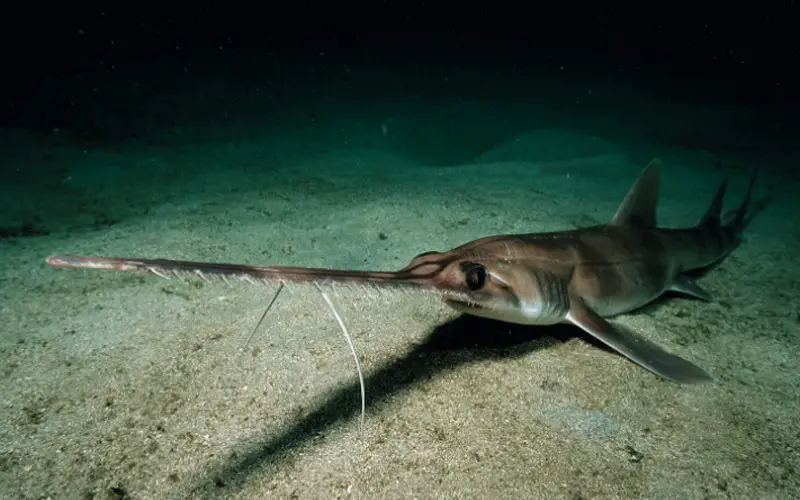
The Longnose Sawshark is a species known for its extended, saw-shaped rostrum, which can be up to one-third of its total body length. Reaching lengths of up to 5 feet (1.5 meters), it has a slender, elongated body with a pale coloration that helps it blend into the ocean floor. The long, sharp snout is equipped with rows of teeth, making it an effective predator.
This species is typically found in the deep waters of the Indo-Pacific, particularly around Australia, New Zealand, and the eastern coasts of Africa. Longnose Sawsharks prefer to inhabit sandy or muddy bottoms at depths between 100 and 1,200 feet (30 to 370 meters), where they can easily maneuver to hunt.
The Longnose Sawshark hunts by swinging its long snout from side to side, disturbing the ocean floor and uncovering hidden prey. It feeds primarily on small fish, crustaceans, and cephalopods. Though they are not a threat to humans, their rarity and deep-water habitats make them seldom encountered.
Angel Shark (Squatina squatina)

The Angel Shark is a flat-bodied shark that resembles a ray with its wide, wing-like pectoral fins and flattened body. Growing up to 6.5 feet (2 meters) in length, the Angel Shark has a broad, diamond-shaped head and a mouth located on the underside of its body. Its coloration ranges from sandy or grayish brown, allowing it to blend seamlessly with the ocean floor.
Angel Sharks are typically found in the Mediterranean Sea and the eastern Atlantic Ocean, especially around the coasts of Europe and North Africa. They prefer shallow waters with sandy or muddy bottoms, often at depths of 65 to 650 feet (20 to 200 meters), where they use their camouflage to ambush prey.
Angel Sharks are ambush predators, lying in wait on the ocean floor and launching quick attacks on passing fish and invertebrates. Despite their relatively docile nature, they are capable of striking fast when they sense prey nearby. They are not known to be dangerous to humans but may bite if threatened or provoked.
Japanese Angel Shark (Squatina japonica)
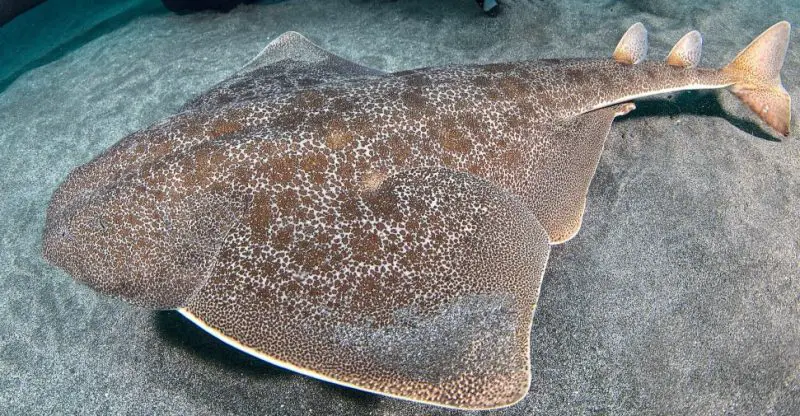
The Japanese Angel Shark is a species similar to the Angel Shark but native to the coastal waters of Japan. It has a flat, ray-like body with large, wing-like pectoral fins, and a broad head that makes it look like a stingray. Growing to about 6 feet (1.8 meters) in length, it has a light brown or grayish coloration, with darker patterns that help it blend into its habitat.
This species is found in the waters around Japan, particularly along the coasts of Honshu, Shikoku, and Kyushu. Japanese Angel Sharks typically inhabit sandy and muddy bottoms at depths ranging from 65 to 330 feet (20 to 100 meters). They are well adapted to living in shallow, coastal environments.
The Japanese Angel Shark uses its excellent camouflage to ambush small fish and invertebrates that pass by. It is an ambush predator, lying in wait on the ocean floor and striking rapidly when prey comes within range. Though not aggressive, they may bite if threatened, but they are generally considered harmless to humans.
Indian Swellshark (Cephaloscyllium silasi)

The Indian Swellshark is a small species of shark characterized by its distinctive ability to inflate its body, making it look puffed up when threatened. This shark has a stocky body, large pectoral fins, and a rounded snout, with a dark brown or grayish coloration and lighter spots on its body. It typically reaches a length of around 3 feet (90 cm) and has a relatively slow-moving nature.
Native to the coastal waters of the Indian Ocean, the Indian Swellshark is commonly found at depths of 130 to 330 feet (40 to 100 meters). It inhabits rocky or sandy seabeds, where it prefers cooler waters and a habitat rich in prey. Its habitat includes regions around the coasts of India and Sri Lanka.
The Indian Swellshark is known for its unique behavior of inflating its body to a puffed-up state as a defensive mechanism against predators. When it senses danger, it can also curl into a tight ball, further reducing its size. Its diet consists of small invertebrates, fish, and crustaceans, which it hunts by scouring the ocean floor.
Leopard Shark (Triakis semifasciata)

The Leopard Shark is easily recognized by its distinct markings, which include dark spots and rosettes on its pale grayish body. This shark grows to an average length of about 4 to 5 feet (1.2 to 1.5 meters) and has a slender, streamlined body ideal for swift movement. It is named after its resemblance to the spotted pattern of a leopard’s coat.
Leopard Sharks are found in shallow coastal waters along the Pacific coast of North America, particularly around California. They prefer sandy and muddy bottoms in bays, estuaries, and kelp forests, often found at depths of up to 300 feet (90 meters). These sharks are often seen near shorelines, where they feed and rest.
Leopard Sharks are non-aggressive and generally harmless to humans. They are bottom-dwelling predators, feeding primarily on small fish, crustaceans, and mollusks. They are known to be quite social, often found in schools, and they exhibit an inquisitive nature. Their slow-moving and placid behavior make them a favorite for divers and snorkelers.
Sandbar Shark (Carcharhinus plumbeus)
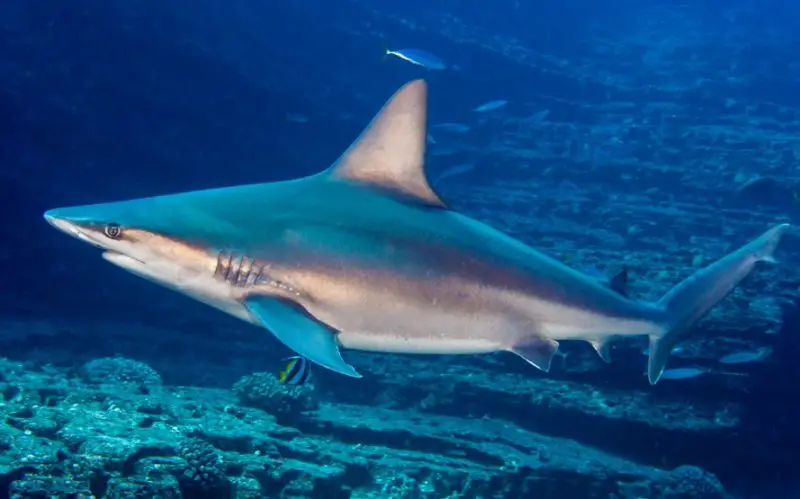
The Sandbar Shark is a medium-sized species, typically growing to lengths of 6 to 8 feet (1.8 to 2.4 meters). It has a robust, heavy-set body with a distinctively large dorsal fin and a broad, square snout. Its coloration is a grayish-brown, with lighter underparts and a noticeable dark stripe along its side.
This species is commonly found in coastal waters around the world, particularly along the Atlantic and Pacific coasts of North America, and is known to inhabit shallow waters like bays, estuaries, and continental shelves. Sandbar Sharks often reside at depths of 10 to 100 feet (3 to 30 meters), preferring warmer waters.
The Sandbar Shark is an opportunistic predator, feeding on a variety of prey including fish, crustaceans, and squid. It is known for its aggressive nature when hunting, but it is not typically dangerous to humans. These sharks are often solitary but may form schools during certain times of the year. Despite their aggressive behavior when feeding, Sandbar Sharks are considered to be relatively shy towards humans.
Dusky Shark (Carcharhinus obscurus)
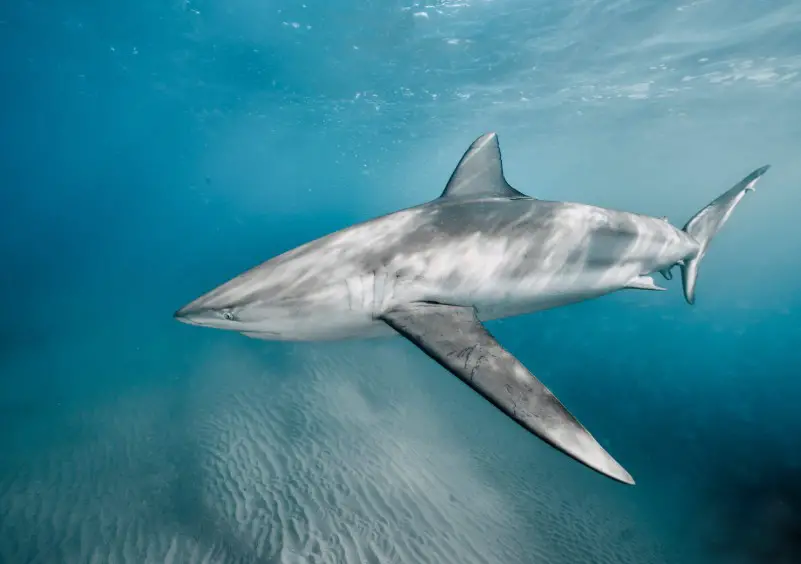
The Dusky Shark is a large, robust species that can grow up to 10 feet (3 meters) in length. It has a long, pointed snout, a wide mouth, and slender body, typically dark gray or brownish with a pale underside. The Dusky Shark’s most distinguishing feature is its large, crescent-shaped tail and a powerful, streamlined body built for speed.
Dusky Sharks are found in deep, warm waters across the Atlantic and Pacific Oceans, often inhabiting the continental shelves and slopes. They are migratory, traveling long distances, and are typically found at depths of 100 to 500 feet (30 to 150 meters). These sharks are often seen in both coastal and offshore areas, including open waters.
Dusky Sharks are opportunistic hunters that feed on fish, rays, and squid. They are known for their aggressive feeding behavior and are capable of catching fast-moving prey. While they are not considered dangerous to humans, they are large and powerful, making them formidable predators. Their migration patterns and territorial behavior make them an interesting subject for research.
Blue Shark (Prionace glauca)
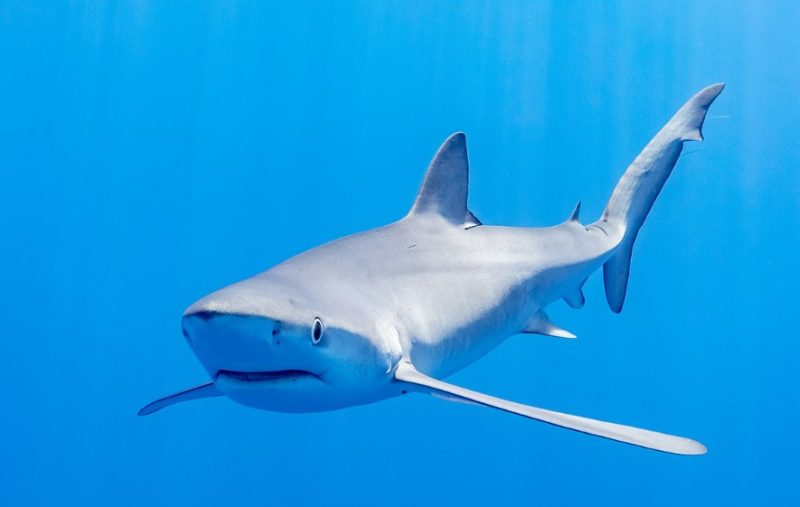
The Blue Shark is one of the most widely distributed shark species, known for its sleek, elongated body and vibrant blue coloration, which fades to a lighter underside. This shark can reach lengths of up to 12 feet (3.6 meters) and is highly streamlined for fast swimming. It has a long, pointed snout and large, crescent-shaped fins that aid in its efficiency as a predator.
Blue Sharks are found in deep, temperate and tropical oceans worldwide, typically in both coastal and offshore regions. They prefer open waters, often seen at depths between 100 and 1,000 feet (30 to 300 meters). Despite their preference for deep waters, they are often found near the surface, especially during nighttime hunting periods.
Blue Sharks are pelagic hunters that feed on small fish, squid, and other marine animals. Known for their speed and agility, they are often seen hunting in groups, chasing after schools of prey. While they are not usually aggressive towards humans, Blue Sharks have been involved in occasional encounters with divers. Their wide distribution and efficient hunting skills make them a prominent shark species in the ocean.
Sand Tiger Shark (Carcharias taurus)

The Sand Tiger Shark is a large, powerful predator with a distinctive appearance, characterized by its ragged teeth that often protrude from its mouth even when closed. Growing up to 10 feet (3 meters) in length, it has a long, bulky body with a light grayish-brown coloration and a pointed snout. The Sand Tiger Shark’s aggressive look is coupled with a relaxed demeanor when not hunting.
Found in coastal waters worldwide, Sand Tiger Sharks inhabit the continental shelf, often at depths ranging from 20 to 200 feet (6 to 60 meters). They are often seen in shallow waters along the Atlantic and Pacific coasts, including bays, estuaries, and near-surface waters during the night.
Sand Tiger Sharks are opportunistic feeders, preying on fish, rays, and even small sharks. They are unique in their hunting technique, often gulping air from the surface to maintain buoyancy and remain near the ocean floor while hunting. Although they have a fearsome appearance, Sand Tiger Sharks are not typically dangerous to humans. Their behavior is relatively non-aggressive unless provoked.
Tawny Nurse Shark (Nebrius ferrugineus)
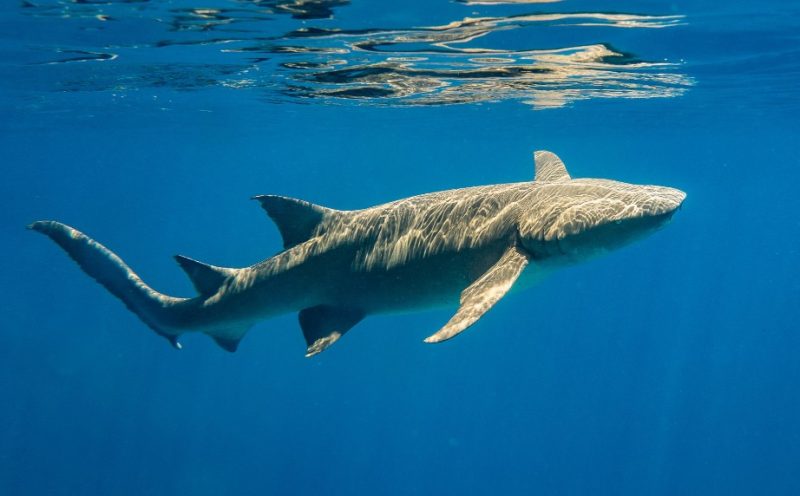
The Tawny Nurse Shark is a slow-moving species with a distinctively broad, flattened body and a relatively short snout. It is characterized by its brownish-tan coloration with lighter spots, giving it a camouflaged appearance that helps it blend into the ocean floor. These sharks typically grow to lengths of about 8 to 10 feet (2.5 to 3 meters) and have long, soft, and flexible bodies that make them excellent bottom dwellers.
Found primarily in the warm, shallow waters of the Indo-Pacific region, the Tawny Nurse Shark is often seen in coral reefs, lagoons, and sandy or muddy seabeds. It prefers depths of around 30 to 200 feet (9 to 60 meters) and can be found in areas such as the coasts of Indonesia, Malaysia, and the Philippines.
Tawny Nurse Sharks are nocturnal, primarily feeding at night. Their diet consists mainly of fish, crustaceans, and mollusks, which they hunt by using their sensitive barbels to detect prey hiding on the seafloor. Despite their somewhat intimidating appearance, these sharks are generally non-aggressive toward humans and are often seen resting motionless during the day.
False Catshark (Pseudotriakis microdon)
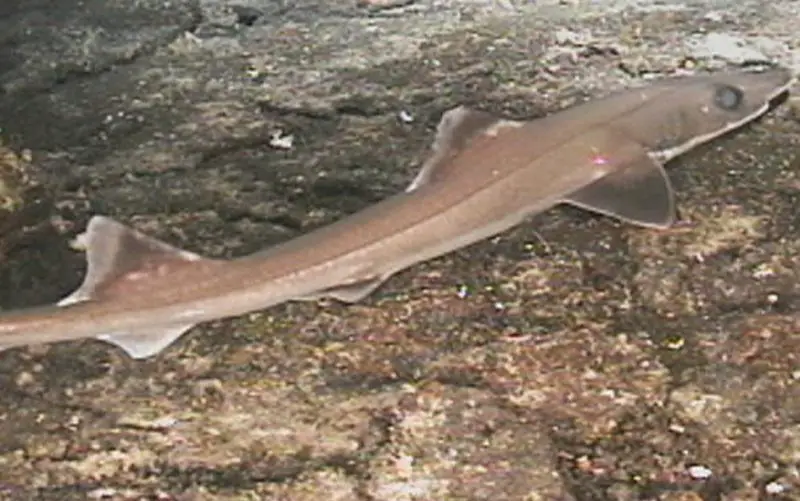
The False Catshark is a medium-sized shark known for its sleek, elongated body and large, cat-like eyes, giving it a distinctive appearance. It has a pale gray to brownish coloration with small, scattered dark spots along its body. This shark typically reaches lengths of about 4 to 5 feet (1.2 to 1.5 meters) and is notable for its unique combination of catshark-like features with a more slender body profile.
Native to the deep waters of the Indo-Pacific region, the False Catshark is found in areas such as the central and western Pacific, as well as the Indian Ocean. It prefers deep, offshore waters, often inhabiting depths of around 300 to 1,000 feet (90 to 300 meters), where it hunts for prey in the dim light of the ocean depths.
This shark primarily feeds on smaller fish, squid, and other invertebrates. Its hunting technique involves utilizing its keen eyesight and the ability to navigate through deep waters where other predators might struggle. The False Catshark is known to be relatively shy, with few recorded interactions with humans due to its preference for deep, isolated waters.
Broadnose Sevengill Shark (Notorynchus cepedianus)
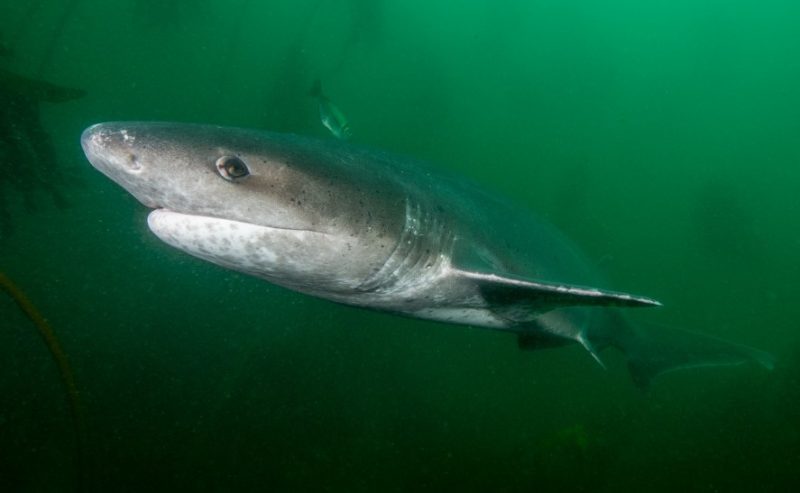
The Broadnose Sevengill Shark is a large, powerful species that gets its name from having seven gill slits, which is one more than most other shark species. This shark has a robust body, a broad, flattened head, and a thick, muscular tail. Its coloration is typically gray or brown with a lighter underside, and it can grow to lengths of up to 10 feet (3 meters).
Found in temperate and subtropical coastal waters around the world, the Broadnose Sevengill Shark is commonly found near the continental shelf. It prefers shallow, coastal waters and is often seen in bays, estuaries, and around rocky reefs. It is typically found at depths of 30 to 400 feet (9 to 120 meters), although it can also be seen near the surface.
Broadnose Sevengill Sharks are opportunistic predators, feeding on a wide variety of prey, including fish, rays, and even smaller sharks. They are known for their aggressive hunting behavior and are often solitary or found in small groups. While they are not typically dangerous to humans, their powerful build and hunting habits make them formidable predators in their natural habitat.
Sharpnose Sevengill Shark (Heptranchias perlo)

The Sharpnose Sevengill Shark is a smaller species of sevengill shark that shares the characteristic of having seven gill slits. It has a slender, streamlined body with a pointed snout, and it typically grows to about 3 to 4 feet (1 to 1.2 meters) in length. Its coloration is generally a grayish-brown with a lighter underside, and it has small, sharp teeth that are adapted for catching smaller fish and invertebrates.
This species is typically found in deep waters, inhabiting the continental shelves and slopes of temperate and tropical oceans. The Sharpnose Sevengill Shark is distributed throughout the Pacific and Indian Oceans, where it tends to stay at depths of 200 to 1,000 feet (60 to 300 meters). It is most commonly found in areas like southern California, Japan, and New Zealand.
Sharpnose Sevengill Sharks are nocturnal hunters, feeding on fish, squid, and crustaceans. They are highly efficient hunters, using their keen sense of smell to detect prey in the dark waters of the deep ocean. Although they are not considered dangerous to humans, their sharp teeth and nocturnal hunting behavior make them fascinating predators to study.
Bigeye Sixgill Shark (Hexanchus nakamurai)
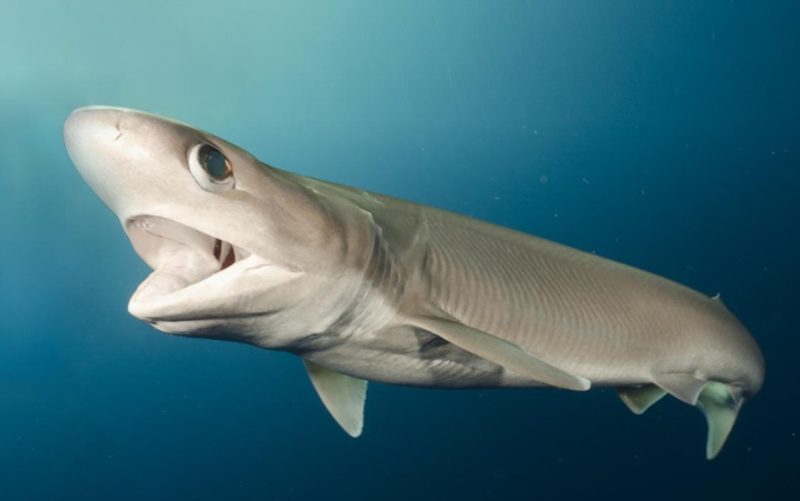
The Bigeye Sixgill Shark is a large, deep-water species known for its distinctive six gill slits, which set it apart from many other sharks. This species has a stocky, robust body and can grow to lengths of about 10 feet (3 meters). Its dark gray or brownish body with lighter underparts allows it to blend in well with the ocean floor, especially at great depths.
Found in deep offshore waters of the Pacific and Indian Oceans, the Bigeye Sixgill Shark typically inhabits depths between 650 and 1,000 feet (200 to 300 meters). It is often found in the deep waters off the coast of Japan and other parts of Asia, where it prefers cooler, deeper regions of the ocean.
The Bigeye Sixgill Shark is an opportunistic predator that feeds on a variety of prey, including fish, squid, and invertebrates. It is known for its large eyes, which are adapted to help it navigate and hunt in the dark depths of the ocean. Though it is not typically dangerous to humans, its large size and predatory nature make it a powerful hunter in its environment.
Bluntnose Sixgill Shark (Hexanchus griseus)

The Bluntnose Sixgill Shark is a deep-sea species characterized by its six gill slits and a broad, flattened head. It has a robust, heavy-set body and can grow to lengths of up to 10 feet (3 meters). Its coloration is usually dark gray or brown, with a lighter underside, and its body is covered in small dermal denticles that give it a rough texture.
This species is found in deep waters around the world, including the Pacific, Atlantic, and Indian Oceans. The Bluntnose Sixgill Shark typically inhabits depths ranging from 300 to 2,000 feet (90 to 600 meters) and is usually found near the ocean floor, where it hunts for prey. It has been spotted in regions off the coast of North America, Europe, and Asia.
The Bluntnose Sixgill Shark feeds on a variety of prey, including fish, rays, and squid. Its large size and powerful jaws make it an efficient predator in its deep-sea environment. Despite its intimidating appearance, the Bluntnose Sixgill Shark is rarely encountered by humans due to its preference for deep, isolated waters.
Crocodile Shark (Pseudocarcharias kamoharai)
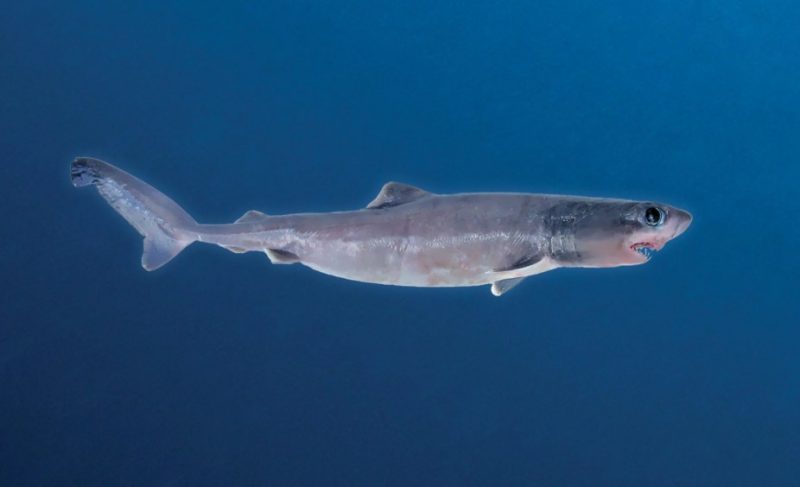
The Crocodile Shark is a small, elusive species known for its distinct appearance, including a relatively large head and a slender, streamlined body. It has a pale gray or brownish coloration with lighter underparts, and its most notable feature is its large, sharp teeth, which resemble those of a crocodile. These sharks typically grow to a length of around 3 to 4 feet (1 to 1.2 meters).
Native to the tropical and subtropical waters of the Indo-Pacific region, the Crocodile Shark is most commonly found in areas such as the coasts of Japan, India, and Indonesia. It prefers deep waters, typically found at depths of around 330 to 1,300 feet (100 to 400 meters), where it hunts for smaller fish and invertebrates.
Crocodile Sharks are nocturnal predators, feeding primarily on squid, small fish, and crustaceans. They use their keen sense of smell and sharp teeth to capture and hold onto prey, much like their namesake, the crocodile. Though they are not considered a threat to humans due to their small size, their aggressive feeding behavior makes them fascinating creatures of the deep.
Brazilian Sharpnose Shark (Rhizoprionodon lalandii)

The Brazilian Sharpnose Shark is a small, agile shark species that is easily recognized by its slender body and pointed snout. It typically reaches lengths of about 4 feet (1.2 meters) and has a grayish-brown coloration with a lighter underside. Its sharp, needle-like teeth and small fins are also distinctive features of this species.
This shark is primarily found in the coastal waters off Brazil and Uruguay, where it inhabits sandy or muddy seabeds and shallow waters. It prefers regions with depths of around 10 to 100 feet (3 to 30 meters), often seen in estuaries and near river mouths where it hunts for prey.
The Brazilian Sharpnose Shark is an active predator that feeds on smaller fish, crustaceans, and squid. It is known for its swift movements and its ability to hunt in both shallow and deep waters. Despite its relatively small size, this shark is an efficient hunter and a common species in its native range. Its non-aggressive nature makes it relatively harmless to humans.
Atlantic Sharpnose Shark (Rhizoprionodon terraenovae)

The Atlantic Sharpnose Shark is a small, slender species commonly found in the western Atlantic Ocean. It has a light gray to brownish coloration with a pale underside and is easily distinguished by its sharp, pointed snout and small, sharp teeth. This species typically reaches lengths of about 3 to 4 feet (1 to 1.2 meters).
Native to the waters of the eastern United States, the Atlantic Sharpnose Shark is typically found in shallow coastal regions, including bays, estuaries, and sandy seabeds. It is most commonly seen at depths of around 30 to 300 feet (9 to 90 meters), often close to the shore where food sources are abundant.
Atlantic Sharpnose Sharks are opportunistic feeders, preying on small fish, squid, and crustaceans. They are known for their fast movements and agility in the water, making them skilled hunters. Though they are not considered a threat to humans due to their small size, their sharp teeth and hunting behavior make them fascinating predators in their coastal habitats.
Smalleye Hammerhead (Sphyrna tudes)

The Smalleye Hammerhead is a smaller species within the hammerhead shark family, characterized by its distinct “hammer-shaped” head. This shark typically grows to about 4 to 5 feet (1.2 to 1.5 meters) in length and has a grayish-brown body with a pale underside. Its small eyes, located closer to the center of its hammer-shaped head, are a defining feature.
Native to the tropical and subtropical waters of the Indo-Pacific, the Smalleye Hammerhead is typically found in coastal regions, including coral reefs and sandy bottoms. It prefers shallow waters with depths of around 30 to 100 feet (9 to 30 meters) and is often spotted in areas such as the coasts of Southeast Asia and northern Australia.
Smalleye Hammerhead Sharks are known to feed on small fish, cephalopods, and crustaceans. They often use their wide, flat heads to hunt and stir up prey from the seafloor. Despite their relatively small size, these sharks are highly effective predators in their coastal habitats and are not considered a threat to humans.
Winghead Shark (Eusphyra blochii)
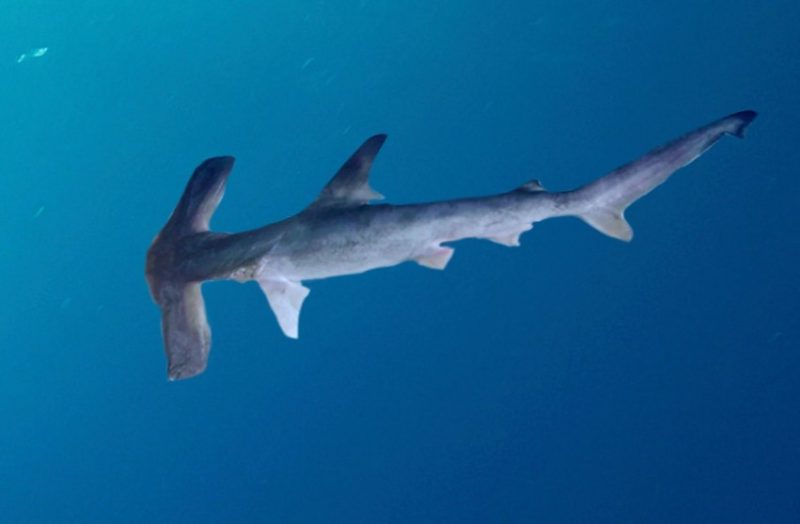
The Winghead Shark is a distinctive species of hammerhead shark known for its unusually wide, flattened head that resembles wings. This shark grows to an average length of around 4 to 5 feet (1.2 to 1.5 meters) and has a grayish-brown or olive-green body with a light-colored underside. Its large, wing-like head is its most remarkable feature, helping it to sense and hunt prey effectively.
Found in the shallow coastal waters of the Indo-Pacific region, the Winghead Shark is commonly found around coral reefs, rocky outcrops, and sandy seabeds. It inhabits waters with depths ranging from 10 to 100 feet (3 to 30 meters) and is typically found in areas such as the Philippines, Indonesia, and parts of Thailand.
Winghead Sharks primarily feed on smaller fish, crustaceans, and cephalopods. They are known to use their wide heads to detect prey buried in the sand or hiding in crevices, making them skilled hunters in their coastal environments. Despite their unique appearance, Winghead Sharks are not considered a threat to humans and are relatively docile.
Sliteye Shark (Loxodon macrorhinus)
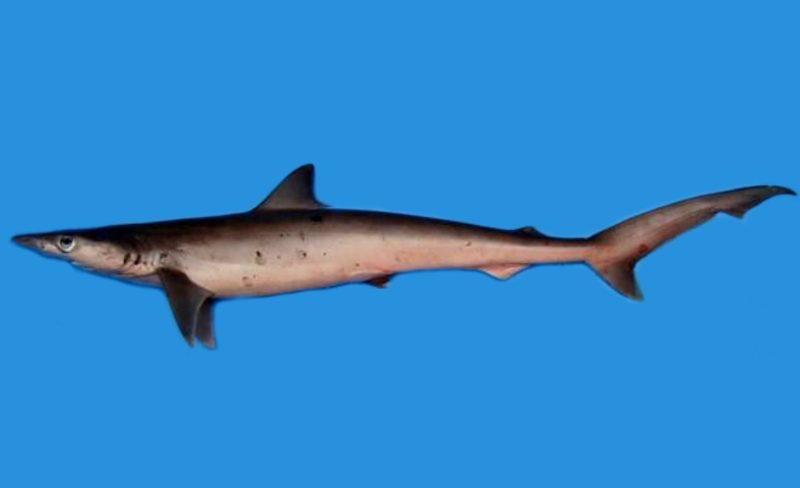
The Sliteye Shark is a small to medium-sized species that is easily identified by its long, pointed snout and relatively large eyes. This shark typically reaches lengths of 3 to 5 feet (1 to 1.5 meters) and has a gray or brownish coloration with a lighter underside. Its sharp, conical teeth are adapted for catching fish and invertebrates.
Native to the coastal waters of the Indo-Pacific region, the Sliteye Shark is commonly found around the continental shelf, where it inhabits depths ranging from 30 to 300 feet (9 to 90 meters). It is typically found in regions such as the coasts of Sri Lanka, India, and Southeast Asia.
Sliteye Sharks are nocturnal hunters, preying on smaller fish, squid, and crustaceans. They are known for their agility and sharp vision, which they use to locate prey in dimly lit waters. While not considered dangerous to humans, their sharp teeth and predatory nature make them effective hunters in their coastal habitats.
Grey Reef Shark (Carcharhinus amblyrhynchos)
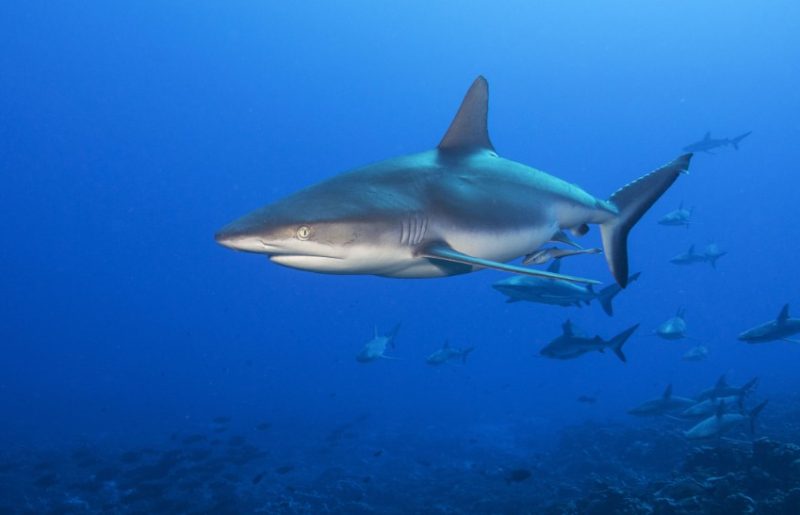
The Grey Reef Shark is a medium-sized species found primarily in the Indo-Pacific region. It has a sleek, streamlined body, typically growing up to 6.5 feet (2 meters) in length. This shark features a grayish-brown coloration with a white underbelly and distinctive dark markings on the tips of its fins. It also has a long, pointed snout and large, triangular teeth designed for catching fish.
Grey Reef Sharks are typically found in coral reefs, where they prefer shallow waters, often near drop-offs and the edges of atolls. They are commonly seen in areas such as the coasts of Fiji, the Philippines, and the Great Barrier Reef. These sharks inhabit depths ranging from 30 to 300 feet (9 to 90 meters), where they patrol their territories.
Grey Reef Sharks are known for their active and aggressive behavior, often seen hunting in groups. They primarily feed on smaller fish, such as groupers and snappers, and occasionally squid and crustaceans. Despite their aggressive hunting techniques, they rarely pose a threat to humans unless provoked, and they play an important role in maintaining the health of reef ecosystems.
Silky Shark (Carcharhinus falciformis)
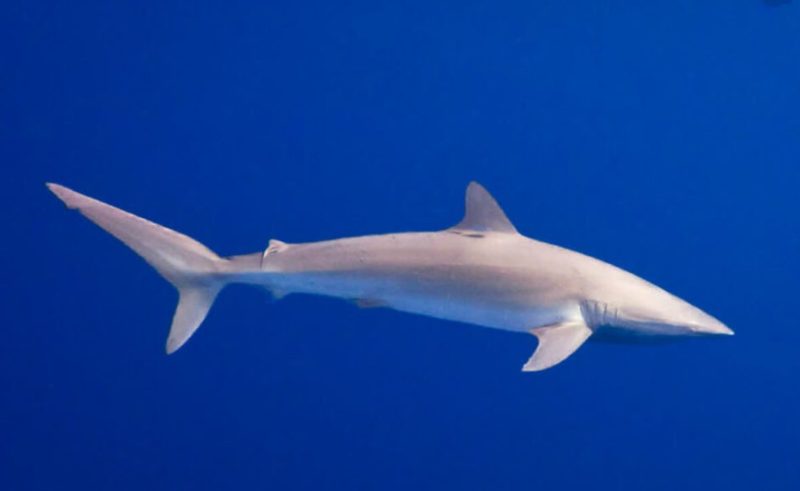
The Silky Shark is a sleek, fast-moving species known for its long, slender body and distinctive silky sheen on its skin, which gives it its name. Typically, it grows to a length of 8 to 10 feet (2.4 to 3 meters), with a light gray to bluish-gray coloration and a pale underside. The shark’s large, crescent-shaped dorsal fin is another key identification feature.
Found in warm, tropical waters of the open ocean, the Silky Shark is commonly seen near continental slopes and island archipelagos. It prefers deeper waters but can occasionally be spotted near the surface. Its range spans across the Indo-Pacific region, including the coasts of Australia, Hawaii, and parts of the Atlantic Ocean.
Silky Sharks are highly efficient predators, feeding mainly on small fish, squid, and other marine creatures. They are often observed hunting in schools, using their speed and agility to capture prey. Despite their speed and predatory skills, Silky Sharks are not considered a major threat to humans, but they are known to be curious and can approach boats and divers in the wild.
Gulper Shark (Centrophorus spp.)

Gulper Sharks are a group of deepwater sharks known for their large, gaping mouths and their ability to swallow prey whole. These sharks typically grow to lengths of around 3 to 5 feet (1 to 1.5 meters) and have a dark brown or grayish coloration, with a lighter underside. They are often recognized by their small eyes and flattened bodies.
Gulper Sharks inhabit the deep waters of the Atlantic and Indo-Pacific Oceans, typically living at depths ranging from 650 to 4,000 feet (200 to 1,200 meters). They are found along continental slopes and in deep ocean basins, where they can remain out of sight from most predators and prey alike.
These sharks are opportunistic feeders, using their large mouths to gulp down fish, cephalopods, and even small sharks. They are slow-moving and often rely on ambush tactics to capture prey. Gulper Sharks are not a threat to humans due to their deepwater habitat and non-aggressive nature, making them elusive and seldom encountered.
Mouse Catshark (Galeus murinus)
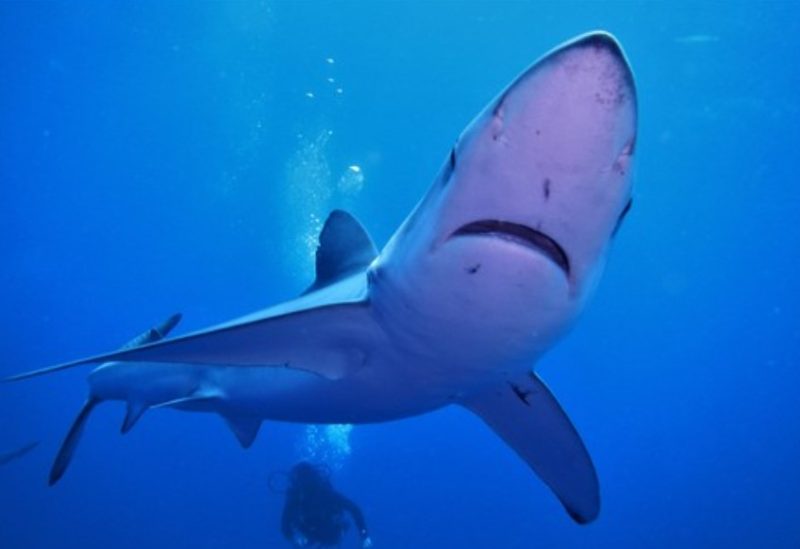
The Mouse Catshark is a small, elusive species of catshark that can be found in the deep, temperate waters of the North Atlantic and Mediterranean Sea. Typically reaching lengths of 2 to 3 feet (0.6 to 1 meter), it has a slender body with a grayish or brownish coloration, featuring small dark spots along its back and sides. Its long, pointed snout and small, sharp teeth make it distinct from other catsharks.
Mouse Catsharks prefer deep waters at depths ranging from 330 to 3,300 feet (100 to 1,000 meters) and are often found along the continental slopes. They are more commonly seen off the coasts of Europe, particularly in the Mediterranean Sea, and in parts of the North Atlantic, where they inhabit cooler waters.
These sharks are nocturnal predators, feeding primarily on small fish, crustaceans, and invertebrates. Their small size and elusive nature make them difficult to study, and they are rarely encountered by humans. Mouse Catsharks play an important ecological role in their deep-sea habitats but are not a threat to human safety.
Black Dogfish (Centroscyllium fabricii)
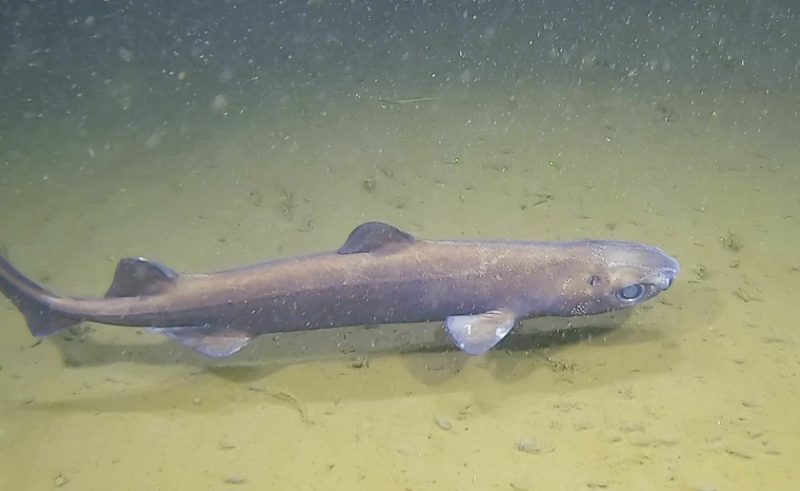
The Black Dogfish is a small, deepwater species that is found in the cold waters of the North Atlantic. It typically reaches a length of about 2.5 feet (0.8 meters) and has a dark, almost black coloration with a lighter underside. The Black Dogfish is known for its cat-like eyes, which give it a unique appearance compared to other dogfish species.
This shark inhabits the deep ocean, often at depths of 650 to 4,000 feet (200 to 1,200 meters), where it can be found along continental slopes and in colder regions of the Atlantic. It is most commonly spotted off the coasts of Greenland, Iceland, and Norway.
Black Dogfish are opportunistic feeders, preying on small fish, cephalopods, and invertebrates. They are slow-moving and rely on their deepwater habitats to avoid most predators. Though they are not considered a threat to humans, their remote habitat and cryptic nature make them a mystery to many researchers.






